Full Moon Check-in
- Last: On a boat in Ha Long Bay with Rosaline.
- Current: Walking back from tipsy tubing in Vang Vieng, feeling rather tipsy!
- Future: In Lombok, at a surf camp.
If you travel around Vietnam you will hear about motorbiking around the north, it’s the done thing to do. What you’ll likely hear about is the Ha Giang loop. It’s a well established 3 or 4 day loop with amazing scenery and zero stress. There are loads of guesthouses that arrange tours which include an ‘easyrider’, a local guy (I didn’t see any women doing it) who drives the motorbike while you sit on the back. As part of a group you’ll tour around the loop, staying at homestays with lots of other people doing the same thing. It’s social and fun. Rosaline and I did this together and had a lovely time. In contrast to this touristy loop, I also did the Cao Bang loop, a little way to the east of the Ha Giang loop. This was a completely different experience. I drove myself and did it all alone (this was whilst Rosaline was doing her exam in Hanoi). I met other tourists only at one homestay and for the rest of the time I didn’t meet anyone other than locals. I had no plan and drove and stopped where I fancied, checking out weird villages and tiny roads that cut along lakes. Here’s an overview of the two experiences.
Not touristy, drove alone.
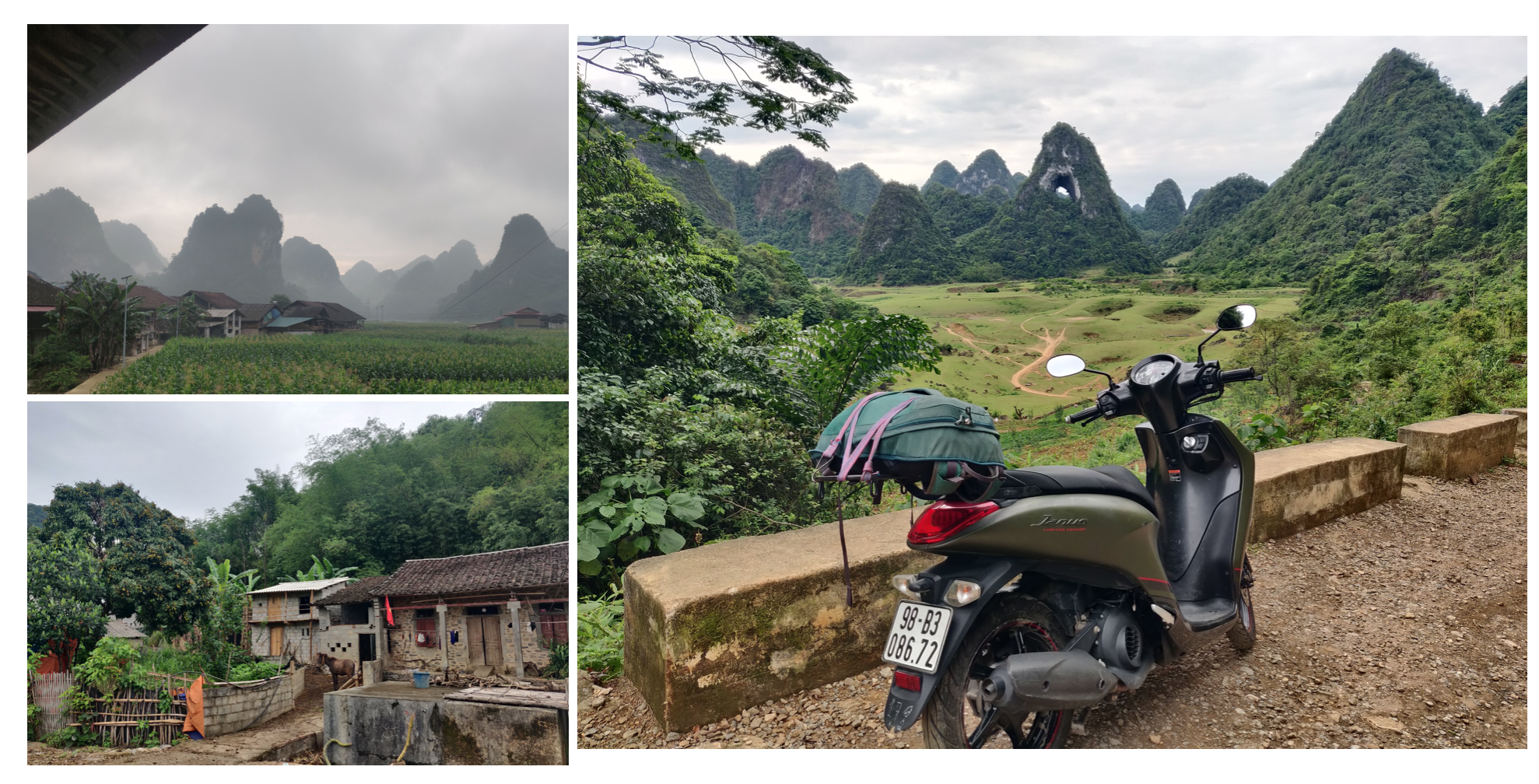
My trip got off to a slow start when it took several attempts to find somewhere good to hire a bike from and to get some advice about where to explore. It was the beginning of the afternoon by the time I finally set off, taking just a small bag with me and with a banh mi and some pineapple stored in the seat compartment for lunch. Immediately I felt amazing. The joy of having complete freedom and no plan! The roads were smooth, the bike very fancy and the scenery beautiful. As lovely as it had been to travel with Rosaline, it was exciting to be alone again. I stopped for lunch at the ‘Mountain Eye’, pausing at the top of the hill in surprise at how cool it was. A huge mountain with a hole in it, very Jurassic park looking. I found a rock to perch on and ate my food, watching the buffalo graze and taking in the view. I tried to follow a trail but it quickly disappeared and I eventually had to cut down through a crop field and over a wall to get back to a clear area to walk along. I meandered my way along the roads, taking a turn down a paved track to get a better look at a lake surrounded by the tall hills and came across lots of kids on bikes. They all shouted hello and raced me along the track. I rejoined the main road and continued to a homestay, arriving with lots of time before sunset. The owner didn’t speak any english but refused to let me stay. From what I could understand I needed a special permit from the police to stay overnight in this specific homestay because it fell within an autonomous border region, and it was too late to get the permit that night. Unsure how big this autonomous region was I set back out on the bike feeling a little stressed about finding somewhere I could actually stay - the downside of no planning! Realising that I would make it somewhere before it got properly dark I relaxed into the drive, and actually enjoyed the faster more purposeful driving. The homestay I settled on was lovely, with a huge outdoor terrace directly alongside a river. My dorm room was actual a little private one, albeit a very simply one with the mattress on the floor, a mosquito net and fan. I enjoyed a nice enough meal with two Australian guys. We drank cold beers and relaxed all evening, sitting on the little bamboo raft that was attached to the river bank. The evening was brought to a close when a dog stole my sandal (we got it back don’t worry!).
After a picturesque breakfast, the other tourist at the homestay, an American Malaysian lady called Annie, asked if I wanted to join her for a hike. It sounded like the perfect way to spend the day so I agreed. We hiked for 4 hours, setting off along a gravel track into the hills. Every turn revealed more beautiful scenery. The clouds had drawn in and it drizzled with rain the entire time, a nice reminder of walks back in England. After 2.5 hours of walking we emerged from the hills and joined a small road which we followed back to the homestay, passing through several villages. Here we witnessed rural Vietnam. It was poor. The facilities were similar to Nepal, showers outside for example, but the pride in the home wasn’t there. Peering inside the houses were undecorated, unfurnished, and untidy. There were older farm houses made of wood, and newer ones made of the concrete blocks which looked half finished. There were dogs everywhere and we armed ourselves with sticks and rocks. The people were friendly once spoken to, but gave suspicious looks before this. We saw a wedding and heard lots of karaoke. Annie told me about her 8.5 years in an ashram in India and I enjoyed her advice and view of the world. Arriving back in the late afternoon I drove a little way to a stone village which seemed to be exclusively homestays. I picked one and drank coffee in a cave until dinner. Being the only guest this time, I ate dinner with the family, obliging to the shots of alcohol they gave me. They didn’t speak any english and didn’t seem interested in trying to communicate so it was a quiet meal for me, listening to the flurry of conversation between them and their neighbours.
I killed time so I got to the Ban Gioc waterfall at 11am, the best time to visit as it was when the Chinese stopped diverting the river to the hydroelectric plant. The waterfall was incredibly strange, with China on one side and Vietnam on the other, boats of tourists being launched from both banks. I popped myself on a bench and people watched for a while, finding the whole atmosphere bemusing with its loud music and staged horses for photos. I tried roasted chestnuts for the first time and loved them, stopping frequently on the long scenic drive to admire the view and eat a few more. I had read online about a ‘foraging’ village in the area so visited this. It took an embarrassingly long time for me to realise that it was in fact a forging village and I’d misread the article. Finally the swathes of knives for sale on the road made sense! What gave it away was the chorus of clanging metal and every single elevated house having a little forge underneath it. A whole village of forgers, how strange. It seemed diversifying industry really hadn’t caught on here when the village my homestay was in turned out to be an incense village. Every household here made incense sticks, visible in pots alongside the small tracks. I really enjoyed walking around these tiny villages, watching what was going on and being generally nosey. Two old woman sat making, unsurprisingly, incense sticks gestured for me to join them so I did. They showed me the facebook live video of someone singing that they watching, giggling away like little girls as they worked, sharing their snacks with me. It was so lovely to simply sit in their presence, even if we couldn’t communicate. I had a disappointing dinner with one of the dishes being literally a bowl of hot water with potatoes and carrots floating in it, not a flavour in sight. Again I was the only guest, but was sat on a separate table from the family which felt odd and unfriendly. The house was notably bare inside. My accommodation was very pleasant, in a wooden elevated structure with a nice balcony. Sadly, looks were deceiving and I had a traumatic night. The first warning sign was when I noticed the little chocolates I had placed on the table were gone, how confusing. As I settled into bed I was startled by a scuttling sound near my head, then above me along the top of the wall, then under the bed. It dawned on me what had happened to my chocolates - there was a rat! It freaked me out a lot, and I tried to scare it away by turning on the light and thumping the bed. It worked for a bit but then it returned. I gingerly placed my foot on the floor, leaving the safety of the bed, which sent the rat scurrying off, and hurried over to my backpack. I placed the pineapple I had brought for breakfast safely inside and moved the bag up onto the chair (because obviously rats can’t climb right…). I tried to sleep but the rat continued to terrorise me and freak me out. I felt so stressed out by it, cowering in the centre of the bed under the mosquito net which I hoped would also be rat proof, watching the room and the flashes of the rat. I slept with the light on and some music playing for a bit, hoping this would scare it away or at least block out its sounds. Neither worked. I did not get much sleep. Waking early the next morning I put the awful night behind me and enjoyed the gorgeous view out of the door and over the balcony, with the morning mist settling into the crevices of the hills. I went to pack my bag and realised I hadn’t survived the night as unscathed as I’d thought… The rat had chewed through the zip on my bag and had completely broken it, meaning it would no longer zip shut! Feeling exasperated and stressed I informed the owners who couldn’t have cared less and I left in a huff. Over the 45 minute drive back to Cao Bang I tried to not agonise over the rat and the bag issue with little success. I had a bad feeling that something else was going to go wrong that day so was very relieved to return the bike safely! I had a delicious breakfast with the super friendly lady who I rented the bike from and started to feel positive again. On the bus back to Hanoi I realised that it was my fault for the rat issue really, having taken the pineapple up to my room, and that I was very lucky to not know that it was a bad idea, having never had to worry about rats before. Turns out I wasn’t completely wrong with my bad feeling about the day, and my motorbike lift from the bus station to the centre of Hanoi was horrific and I totally thought I was going to die. The old man driving me seemed drunk and chaotic was an understatement for his crazy swerving, shouting and constant spitting and snot rocketing. When he dropped me off at the wrong hotel I didn’t even correct him, leaping off the bike and walking the rest of the way instead. Luckily, I needn’t have stressed about my bag being broken. I found a street full of repair shops and got the zipper replaced in 15 minutes and for a cost of £2. It’s not the best job in the world but it’ll last the rest of the trip.
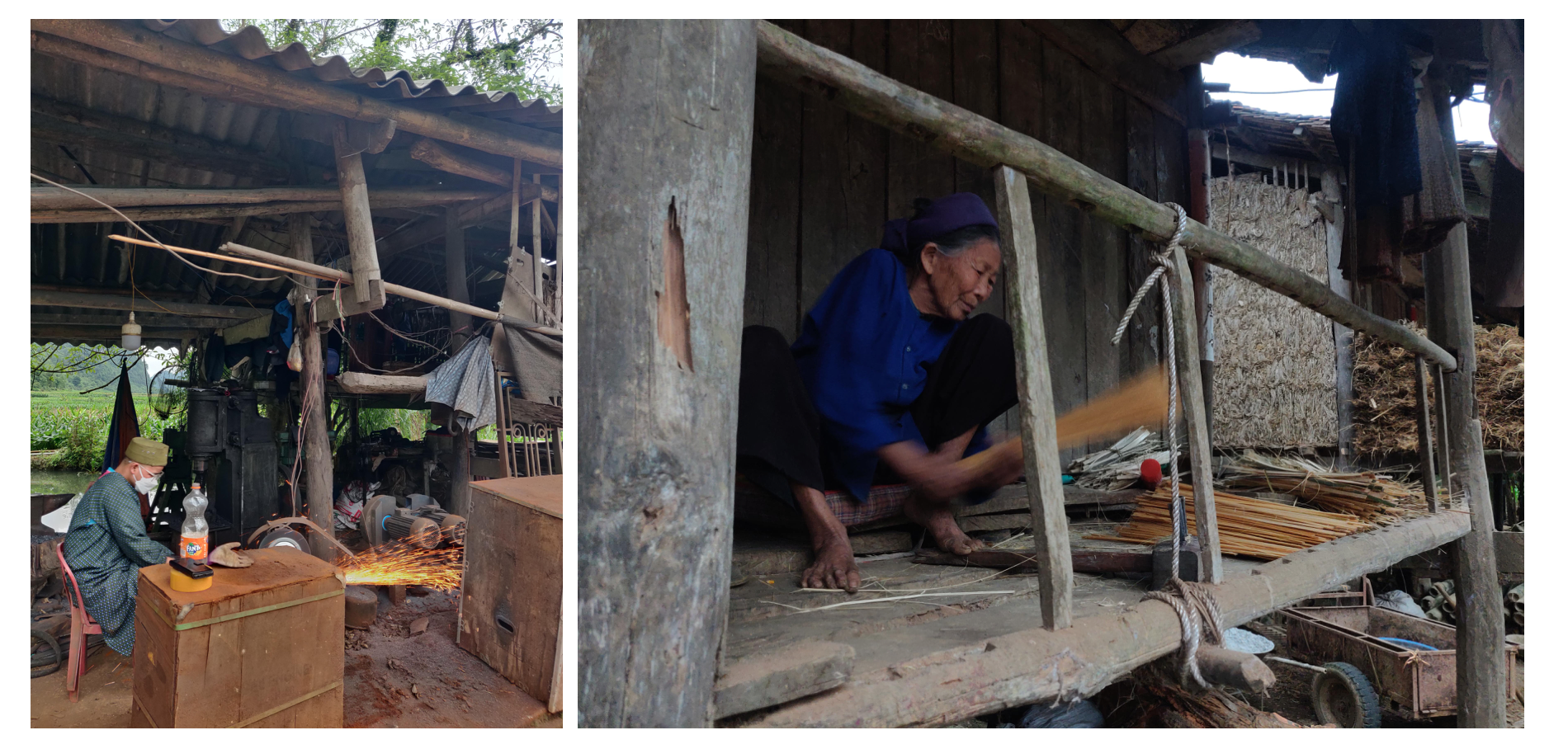
So, not everything went smoothly on my solo adventure around Cao Bang, but I loved it. It was so much fun to have complete freedom. The scenery was stunning (a given in Northern Vietnam it seems). Having the opportunity to explore tiny villages, observe local life and interact with people was wonderful. It was the only time in Vietnam that I felt like I really experienced local life. After being surrounded by travellers for so long it was also refreshing to get away from the backpacking trail for a few days. The homestays were disappointing compared to the ones I’d had in Central Asia, with the families having no interest in socialising and being unfriendly even. Overall, an imperfectly wonderful few days!
Touristy, did as part of a group, was a passenger.
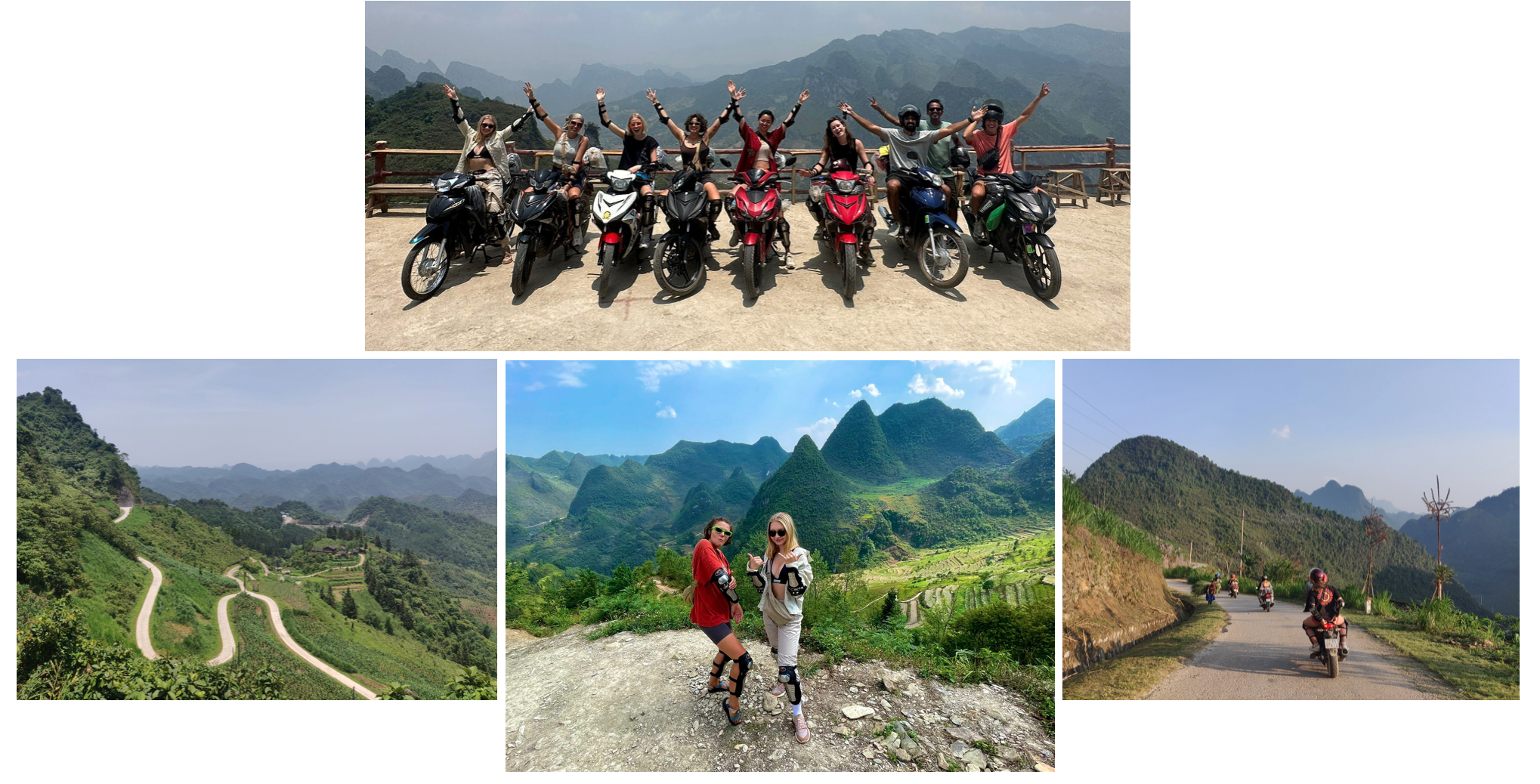
After hearing lots of stories from other travellers who had already done the loop, Rosaline and I decided to go with Mama’s house hostel and to both get easyriders (mine was called Ning). Whilst I was happy driving a scooter now, I hadn’t tried a semi-automatic which was needed for the loop and had learnt that I struggled to both admire the view and watch where I was driving! We opted for the four day option (as opposed to the three day one) which cost £150, with all of the accommodation and food included. For comparison, in Cao Bang I spent £50 for four days so it’s a lot cheaper to do it yourself, unsurprisingly. We had a very confusing and disorganised start but once we set off in our group of 13 it calmed down. The next four days were spent sat on the bag of a motorbike, listening to Rosaline and I’s spotify blended playlist under our helmets, enjoying the most magnificent views and often holding our arms out like we were on the Titanic. We drove in our group the whole time, stopping frequently to look out from viewpoints, walk to the Chinese border, swim at waterfalls and eat ice creams. After mid-morning on the second day our group did fall to 11 members after one of the people self-driving had a crash which saw her cut up her chin pretty badly and chip a tooth. Luckily it wasn’t more serious! She and her husband left for the hospital and sadly didn’t return. The rest of our group was made up of two guys from India and all of the others were dutch and of a similar age to us. This was great for Rosaline who could chat away in dutch with them all, but less great for me. It was actually the first time in my trip where I felt isolated because of language, with the people around me not switching to english to accommodate for me. On one hand, I’m glad I got to experience that isolation so I can be more sympathetic to others who aren’t super fluent in english, and it made me realise how fortunate I am that people have always accommodated me in the past. On the other hand, it was isolating and did start to get to me a bit after four days. Luckily, in the evenings we combined with several other groups to create a mega group at the homestays. Whilst most of these people were also dutch and stuck to speaking dutch, there were other nationalities too so I could speak english with them. The evenings were passed by socialising, eating basically the exact same meal and playing cards. Oh, and also drinking rounds and rounds of ‘Happy water’, a rice wine spirit that left a lot to be desired. It was a lot of fun but did give me school trip vibes sometimes. Whilst the social side wasn’t exactly the best experience for me, the scenery really was. Blessed with perfect clear weather everyday, we were treated to far and wide views of tree covered karsts, snaking roads, deep valleys and terraced hillsides. Unlike in Cao Bang, we were often above the scenery here, looking down on it from brilliant viewpoints. The colours were vibrant even against the bright sun. The driving was enjoyable and the roads were good, with the exception of day three where lots of it was on a dirt track under construction. We got covered in dust and it was hairy at times. But after this was my favourite bit of driving. It was golden hour and the sun was just beginning to set. We flew down a long, steady hill to descend into a valley. The views to the left were stretching and drenched in that soft glow. We overtook each other on the bikes and you could tell everyone felt the same - in awe at the surroundings and exhilarated by the drive. We arrived to our final homestay on this high and enjoyed the fact it had a pool, watching the rest of the sunset from here over a cold beer. Whilst driving through the villages we saw lots of sights, including a huge live pig being transported strapped to the back of a motorbike. It was really interesting to drive through these places and be able to look into the eyes of the people there as you drove past. We saw children playing, happily shouting hello to us, some even stretching their hands out to high five. We saw children with the saddest eyes I’ve ever seen, walking alone along roads in the searing heat or sat under umbrellas selling things. We saw women together, laughing. And we saw a woman sat crumbled on the ground looking utterly defeated. It really made clear the different sides to rural, village life in developing countries. We never stopped and interacted with people in these villages sadly, I felt a lot more like just an observer than in Cao Bang. So that was the infamous Ha Giang loop!
Rosaline and I spent a little over 3 weeks in Vietnam. A little over 2 of those weeks were spent in the North, hence the quick run up Vietnam title. I’ll talk you through our journey.
Phnom Penh → Ho Chi Minh → Hoi An → Hanoi → Ha Long Bay → Ninh Binh → Hanoi → Cao Bang → Hanoi → Ha Giang → Hanoi

Phnom Penh → Ho Chi Minh → Hoi An → Hanoi

From Phnom Penh, Cambodia, we took a rather nice bus to Ho Chi Minh, Vietnam. I really rate SE Asian buses, they have ample leg room, the seats recline right back, and on this one we were given delicious croissants and iced coffee! The border was seamless and soon enough we arrived in the city. We had only 24 hours in Ho Chi Minh but that was enough for me to be honest. It was just a big city. I quite liked its architecture, a mix of french colonial, soviet style concrete and modern glass skyscrapers, creating a collage effect. It was clean but the roads were busy. It was full of lovely cafes and restaurants, but the streets themselves weren’t particularly nice. A part from cafe hopping and getting our first tastes of Vietnamese food (hello Banh Mi) we saw fireworks in the evening for Reunification Day (the anniversary of the halves of Vietnam being reunited into one country) and went to the War Remnants Museum. Doing this so soon after the museums in Phnom Penh did make us both feel slightly overwhelmed by the cruelness of humans. This manifested physically with us both needing to use the herbal inhaler my family member gave me in Thailand (clearly I looked very stressed then) to fight off any fainting; with Rosaline having a little cry outside; and with my arse sweating in the most strange place leaving a very odd mark on my shorts. Perhaps some of it was the unbelievable heat and humidity. We caught an overnight train from Ho Chi Minh to Hoi An, travelling for 19 hours in a carriage that was reminiscent of the ones in Central Asia. I passed the evening by writing a blog post and snacking on apples and peanut butter. Rosaline replied to work emails and tried to make headway in applying for her Indian research visa.
Arriving into Da Nang (not Hoi An directly sadly) another backpacker found us and we all got a taxi together into Hoi An itself, about 40 minutes away. We spent 3 days here. Hoi An is incredibly touristy but in that small seaside town in Cornwall way, rather than the strip in Malaga. The little streets of the old town are narrow, with paper lanterns crossing overhead, lots of the buildings are a rich yellow colour, there are bright flowers crawling up the bricks. Inside the buildings are the usual touristy shops, which in Vietnam includes a lot of coffee beans. At night, the lanterns are lit up and the area around the river becomes alive with people and vendors. This is when Hoi An does cross into the Malaga strip style touristy and I didn’t find it very beautiful despite all of the lanterns and little boats on the water. One look at the bars with neon signs and you were taken from any feeling of authenticity. But did we enjoy going to these bars and dancing all night? Yes of course. I’m not saying I’m not a hypocrite, I am also a tourist at the end of the day. Back from the old town you’ll find slightly less beautiful streets, nice coffee shops and a huge number of tailors. Hoi An is famous for its tailoring so it seemed rude to not partake. Rosaline and I both got measured up which was an interesting experience. Rosaline got a lovely skirt made, and a full suit (yep I was also nervous about how she’d fit it into her backpack but she managed!). I opted for a linen waistcoat. Other activities included walking through harvested rice fields to the beach, spotting buffalo, and a cooking class. This cooking class was much better than the one in Cambodia, much less rushed and I felt like I actually cooked the dishes myself. It oddly included a coconut boat ride which was the epitome of touristy but quite fun. We were paddled along little rivers by a lady covered up completely, including gloves (people here really don’t want to get a tan as it suggests you work outside which is for people of a lower class). We watched men spin in their boats to Gangnam Style loudly played through a huge speaker on another little boat. We watched a man fake fish. We were given a little rod and told to fish for a crab. When we didn’t immediately catch one the rod was snatched away and we were moved on. Like I said, odd. From Hoi An we caught a train overnight to Hanoi, travelling for 17 hours. We passed the evening in much the same way as last time, but also eating the cobbled together dinner of a Banh Mi and some salads.
We arrived into Hanoi for the first time, but not the last! We spent only one night here for now, getting picked up the following morning for our Ha Long Bay tour. After consulting my lonely planet guidebook (taken from a hostel in Cambodia) it seemed the best way to visit the infamous bay was through a tour. We opted for an overnight trip rather than a one day tour as the price difference wasn’t crazy and it allowed for a much more relaxing experience.
Ha Long Bay tour
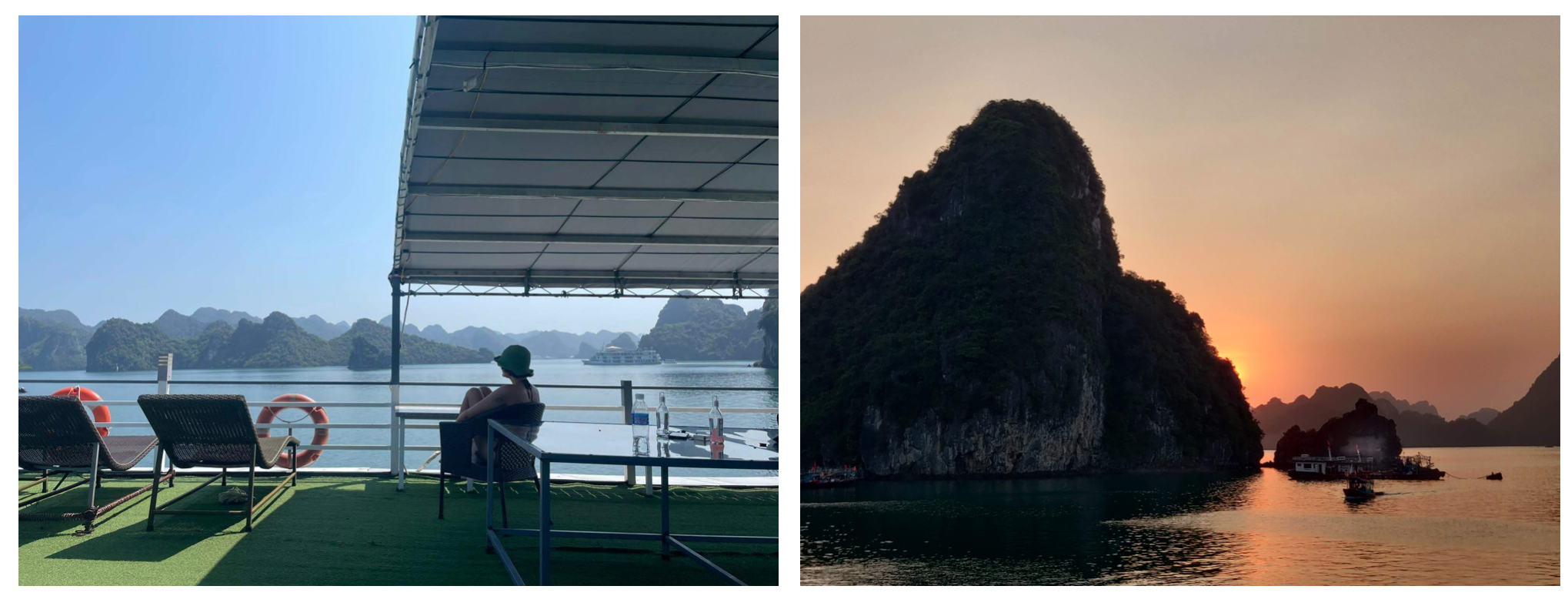
Transported to Ha Long Bay from Hanoi by minibus we stopped at a pearl farm museum and learnt how pearls are made, which was actually really interesting. It was quite hectic at the dock but we quickly boarded a little boat which took us to our cruise boat (I won’t call it a ship as it was tiny). There were only around 17 of us so you can imagine just how small the boat was. We dropped our bags into our room which was private (the luxury!) and very nice. Just before we were served lunch, our guide made a joke to a british guy travelling alone about not being late and he completely lost it. This man went mental shouting at the poor guide about how it “wasn’t on to call him out in front of everyone” and they should “take it outside” etc. The rest of us sat in a stunned silence, staring at the table. Rosaline and I both wanted to say something but also thought the man was so unhinged he might murder us in our sleep if we did. It did provide some entertainment I suppose, but really it was just disgraceful behaviour. Anyway, the boat sailed us through Ha Long Bay for several hours and this is when it struck me how huge the bay is. Ha Long Bay is famous as a bay filled with Karsts, a new word I’ve learnt which describes the columns of rock that appear from nowhere. I was imagining a little bay with maybe 50 of them. In reality, Ha Long Bay covers an area of 1,553 km² with 2000 karsts! Sat in our bikinis looking out at this insane scenery from the roof deck of the boat - it was a pretty cool experience, and we were lucky to get such clear weather. The afternoon was filled with activities that I did not rate highly. We were shuttled through a cave which was unbelievable packed and whilst being very huge, wasn’t that impressive. Then we were shuttled onto an equally packed island to swim on its overcrowded tiny beach. Why we couldn’t drive the boat to an empty space in the huge expanse of the area and swim there I don’t know. The water was pleasantly cool and very needed to wash off the sweat. Although we rose from the water dirtier than when we entered, realising a film of grime was covering our skin. You had to pay to use the showers so Rosaline and I washed each other down using the bathroom sinks before hurrying back to the meeting point to return to our boat. Watching the sunset from the boat made up for the strange afternoon activities. The only meh bit was the fact we were parked up around all of the other boats. I’m guessing there’s some regulation that prevents the boats going to find a quiet spot and parking alone but it’s a shame. After having a proper shower we got dressed up and enjoyed cocktails on the deck whilst making spring rolls and then having dinner. We had an unsuccessful squid fishing attempt and relaxed on the deck, taking in the full moon and the outline of the karsts that surrounded us. The following morning we woke up for sunrise, popped our heads out of the room to see it was misty and returned to bed, secretly a bit happy. I got up again an hour later and did yoga on the roof - definitely a contender for the best yoga spot of the trip! We went to a pearl farm and visited a museum with the exact same exhibits as the one the previous day which made for a, unsurprisingly, boring visit. More excitingly we got into kayaks here and were able to paddle around, becoming more immersed in the scenery. Back on the boat we returned through the bay and I once again enjoyed just sitting and watching the karsts pass by. At the dock we were transferred to a bus and shipped back to Hanoi. I slept the entire bus journey, completely worn out from all of the excitement (and sea air).
Ha Long Bay → Ninh Binh → Hanoi

A brief one hour after being dropped in Hanoi from our Ha Long Bay cruise we got a bus to Ninh Binh. While the buses themselves have all been wonderful in SE Asia, the act of getting on them always seems to have a lot of unnecessary steps. Repeatedly we arrive at the pick-up spot and are put into a bus or car, for this bus or car to only take us to another point 10 - 30 minutes away where we are moved into a second bus. Sometimes this happens again when we arrive. We’re never told what’s going on so it can be a bit confusing. We make it to Ninh Binh eventually, or more specifically to Tam Coc which is just to the west of the city. We rent a scooter here and Rosaline trusts me with her life for the first time, hopping on the back as we explore the area. It was one of my favourite days in SE Asia so far. The scenery was absolutely unbelievable. People say Ninh Binh is like Ha Long Bay on land and that’s a spot on description. The same karst structures rise out of the fields from nowhere. Somehow it’s even more striking than Ha Long Bay, I think because of how close the karsts are and how green everything is. We both gawked as we zoomed through the beauty, wind in our hair and excitement in our bones. We made several stops at viewpoints, pagodas, for lunch, and to swap over driver/passenger with me putting my life in Rosaline’s hands. On our way back, as if to remind us of the negatives of exploring by scooter, we saw the aftermath of a crash and stopped to help. Well, Rosaline helped as a medic and I just offered my hand to the poor girl to squeeze. Luckily it wasn’t anything serious, just lots of skin lost to scrapes. As awful as it was, it was cool to see Rosaline in full doctor mode and to realise that we’re actually adults now and have skills to offer the world. Rosaline, wisely, called it a day once we got back to the hostel but I decided to make use of the last bit of daylight to explore one more pagoda. The drive over in the golden hour lighting was absolutely stunning. I just could not get over the karsts rising up from the fields. The pagoda was cute and on my way back I took a left taking a cool looking track through the fields. This turned out to be a bit of a mistake as it got dark and the track become a muddy path. I skidded a few times and did have a minor fall but managed to hold it together long enough to get back on tarmac. Feeling a bit overwhelmed I returned to the hostel, relaxing on the drive. A small, but still quite fun, blip in a truly wonderful day exploring some of the most gorgeous scenery I’ve ever seen. On our last morning in Ninh Binh we went out for a boujee breakfast of smoothie and granola bowls and coconut coffee. The occasion? My one year travel anniversary! (There’s a separate post discussing that milestone). We caught a bus back to Hanoi where Rosaline and I checked into separate places. Don’t worry, we hadn’t fallen out! Even more depressing than that, Rosaline had an online exam to sit for her masters which meant she would be staying in a hotel for a week and I would be entertaining myself. Poor Rosaline.
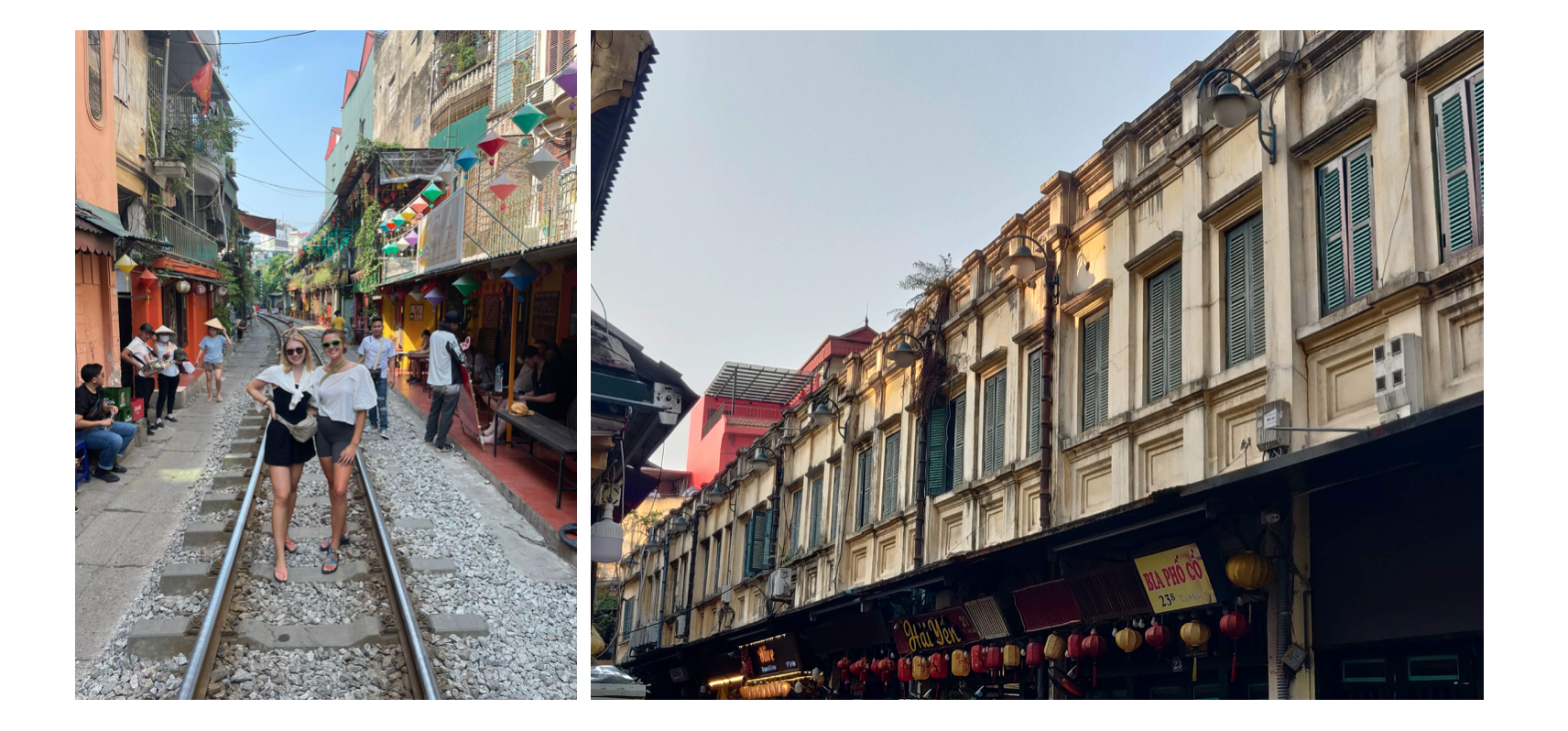
I spent 2 nights in Hanoi, finally taking the time to properly take in the city. It was much more like Kathmandu than it was Ho Chi Minh. It was rough around the edges. The streets were filled with little market shops, selling random goods, and street food vendors. Interspersed were nice looking cafes, which became more frequent as we neared the more touristy area. It was quite dirty and the streets felt dark and oppressive sometimes. I liked the energy of the city, but I wouldn’t call it pretty. I did a walking tour which was very relaxed and casual, not much history sadly, but a good way to socialise. I met lots of lovely people, it is crazy what a difference it makes to travel alone versus with someone in that aspect. I went to the women’s museum the next day with some of the girls I met on the walking tour and was impressed with it, learning about women’s roles in Vietnam and differences in ethnic groups. Train street, a narrow street directly surrounding a train track, was very cool and I visited it both during the day and at night, getting to see a train pass through. It was a bit manic with police saying you weren’t allowed to walk down the street sometimes, but definitely worth seeing. I continued to explore Hanoi whenever I returned in between destinations. There’s a lot to see there, but nothing too special for me.
Hanoi → Cao Bang → Hanoi → Ha Giang → Hanoi
From Hanoi I caught a bus up to the relatively unknown Cao Bang, where I hired a scooter and drove around for a few days. I returned to Hanoi to collect Rosaline after her exam (woo she finished!) and we both travelled up to Ha Giang by bus. Here we did the infamous Ha Giang loop before returning to Hanoi one last time. I’ve covered Cao Bang and Ha Giang in a separate post as this one is already too long!
Thoughts on Vietnam
First off, the scenery is stunning and varied and green and unique. The people are kind but shy. The food, well read below for my views on that. I had a feelng that Vietnam would be my favourite of the SE Asian countries, and I did really likely it, but I’m not sure it’s going to get the top spot. I just didn’t love enough about it.
You may be picking up from the heading that I was more impressed with the coffee than the food in Vietnam, and you would be correct. The food actually really disappointed me. The flavours were always tame, the textures were meh and nothing was that exciting. People weren’t exaggerating when they said it was a lot of noodles, as this was pretty much every dish. It was also the ambience. In Cambodia and Thailand the street food is in the form of little stands, either permanent or on wheels, with tiny plastic stalls and tables alongside them on the roads. In Vietnam, the street food is in little shops along the streets, with the same plastic stalls and tables on the pavement out front. I loved this form less. Some dishes worth mentioning:
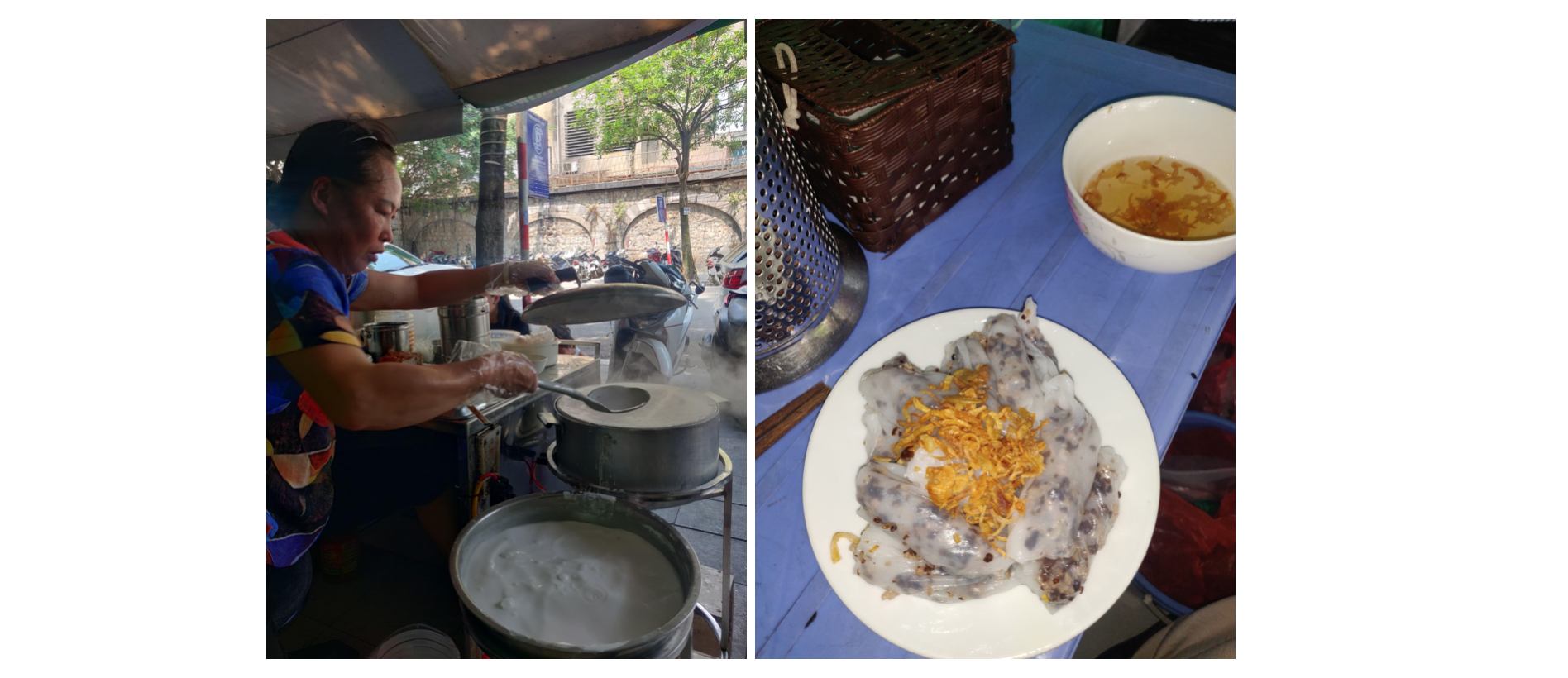
I had high hopes for Vietnamese food and these were in no way met. I hadn’t expected much of Vietnamese coffee and was taken aback by how good it all was! The coffee offering was a lot more diverse than the food:

09/05/23 marks one year since I left England. That’s one year on the road baby! One year living out of a backpack, sleeping in a different bed every few nights, always being on the move. I’ve had some of the best experiences of my life. And I’ve had some really tough moments. I’ve been exhausted, frustrated and lonely. Looking at it as a complete picture, the good and the bad, it’s been the most wonderful thing I’ve done in my life. This is just a little post to update the stats, and talk about my favourite and least favourite parts of travel.
Countries visited: 27
Stamps in passport: 50 (the more recent countries have been very stamp heavy!)
Overnight buses/ferries/trains: 19
Distance travelled (according to polarsteps): 24,935 miles
No specific moments here but some overarching themes.
I wouldn’t change any part of travelling. The less fun bits are important, they provide a challenge and give that feeling of a reward. But these are the bits I find less fun:
A lot of travel is focused on the experience once you’ve arrived somewhere. In homage to the overlooked aspect of actually travelling, here’s a collage of pictures of me on the move, ladled with bags, often exhausted and slightly stressed. They’re in chronological order so enjoy the transition of hot to cold to hot climate, and haircut and growth! The behind the scenes of travelling. The bit people might find less glamorous…


The end date of my trip is beginning to come into sight. I start my job in London at the end of August so will return to England sometime in July to sort myself out. I don’t have an exact date yet, nor an end location. Deciding what to do with my last 2 and a bit months has been a fun but difficult exercise, but I think I have a rough idea now. If you read my Bangkok post you’ll know I regret skipping Myanmar and after considering it further I’ve decided to at least try to visit it overland. My rough plan for now is to finish off northern Vietnam, spend a few weeks in Laos, see northern Thailand, cross into Myanmar and travel down before crossing back into Thailand to do an island in the south, get a ferry to Malaysia and another ferry to Sumatra. Do one last workaway on the little island Nias. Fly home from Singapore or Jakarta. Wish me luck!
It was only a short stint in Cambodia, just 2 weeks. I do feel you can slightly compensate for a lack of time in a country by engaging with it fully. Every tuktuk ride my eyes would be pouring over the streets, my attention given fully to seeing this country. I spent every bus journey listening to podcasts on its history. When I met someone who had travelled around more of it or for longer I asked them about their experiences and opinions. So despite the short time spent in Cambodia, I’ve left with a relatively strong feel for it. The people are smiley and friendly and welcoming, but outside of the cities many seem bored, with not much to fill their time. The scenery is not as green as I expected, but that makes sense seeing as it was the hottest time of the year and pre-monsoon. In the countryside, life is farming and this is basic. Modern machinery like tractors are few and far between with iron buffalo (a motorised ploughing device that still needs to be guided by a person walking behind it) being commonly used. The cities are very modern in comparison, and everything in them seems quite new, probably because it is. The echo of french colonialism is present but it’s quiet. Cambodia is strongly Cambodian. But what it means to be Cambodian seems hushed. The nationalism or culture is not loud or in your face. This is almost seen tangibly in the food, which is so soft and subtle in flavour, lacking any spice usually. I enjoyed Cambodia and I wouldn’t be against going back for longer to properly get a feel for it, but it’s not a priority. It doesn’t rank too highly on my list.
I was overwhelmed by the modernity of Bangkok and felt shaken by it. It wasn’t what I’d become used to and, evidently, what I’d become comfortable with. As I watched out of the window of the bus which took us over the border into Cambodia I was almost thankful to see the familiar sights of little huts selling food, individual cows and buffalo wandering around, and people in the fields using ancient looking machinery. It feels strange to say that those sights made me feel at home, but in a way they did. The border crossing was unbelievably easy, mostly because we’d paid an extra $7 to get the VIP package with our bus ticket (not something I would ever normally do but as it was Rosaline’s first crossing we thought why not) and were waved through with the bus company dealing with our visas for us.
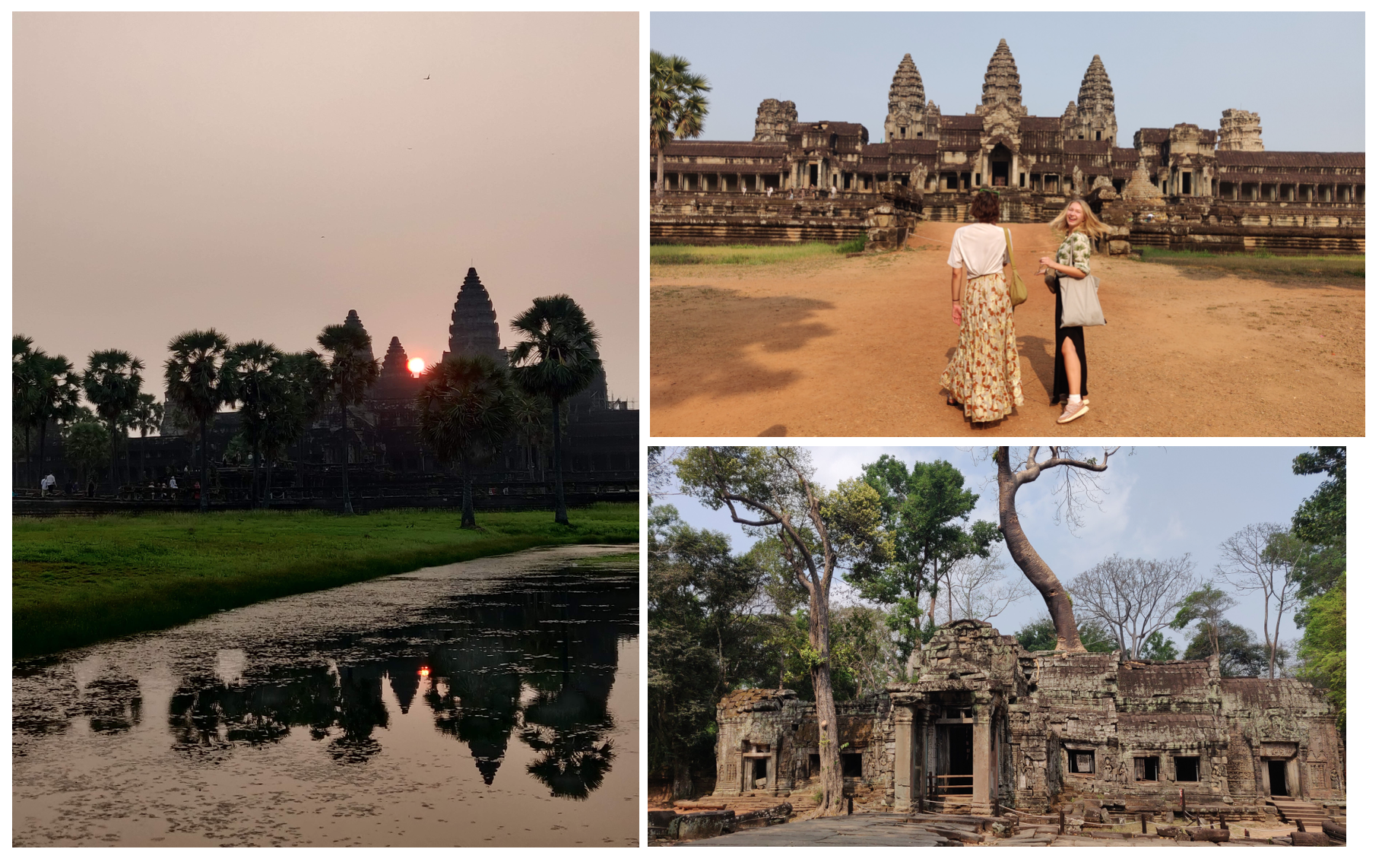
First stop was Siem Reap, a city in the Northwest of the country. It was fine, a very touristy pedestrianised centre with a big street named ‘Pub Street’ and a river with pretty bridges arching over it. Unlike the scenery we’d seen on the drive across the country, it was relatively modern. The hostel was lovely, more like a fun hotel with clean and modern rooms and a big pool. I could get used to this standard of hostel for only £5! We stayed three nights here and had quite a busy time. The first morning we went for sunrise at the infamous Angkor Wat temple complex. The sunrise wasn’t very beautiful because of the clouds/smog and the remaining beauty was tarred by the talk of a particularly arrogant guy on the tour with us from the hostel. Angkor Wat is the name of the largest and most famous temple in the complex, but the complex is ginormous with 72 temples. It was the old capital of the Khmer empire in the 9th - 15th Century. Our tour guide was rubbish so I didn’t learn any more than that from the experience. The temples were impressive but without the history and context I wasn’t so interested. They reminded me of the ones I’d seen in Mexico, but that experience was more enjoyable. The second temple had been half absorbed by the jungle and it was the one used for filming in Tomb Raider. On the final of the three temples we visited Rosaline was bitten by a monkey which tried to steal her sunglasses. After the tour guide continued to be useless, we decided to leave the tour early to go to a hospital and get her the antibiotics and rabies jabs she needed, which we managed to sort fairly stress free. Now she’s fully recovered and safely out of the rabies window, I’d like to point out that this was the first hospital visit of my entire trip and it wasn’t even for me!
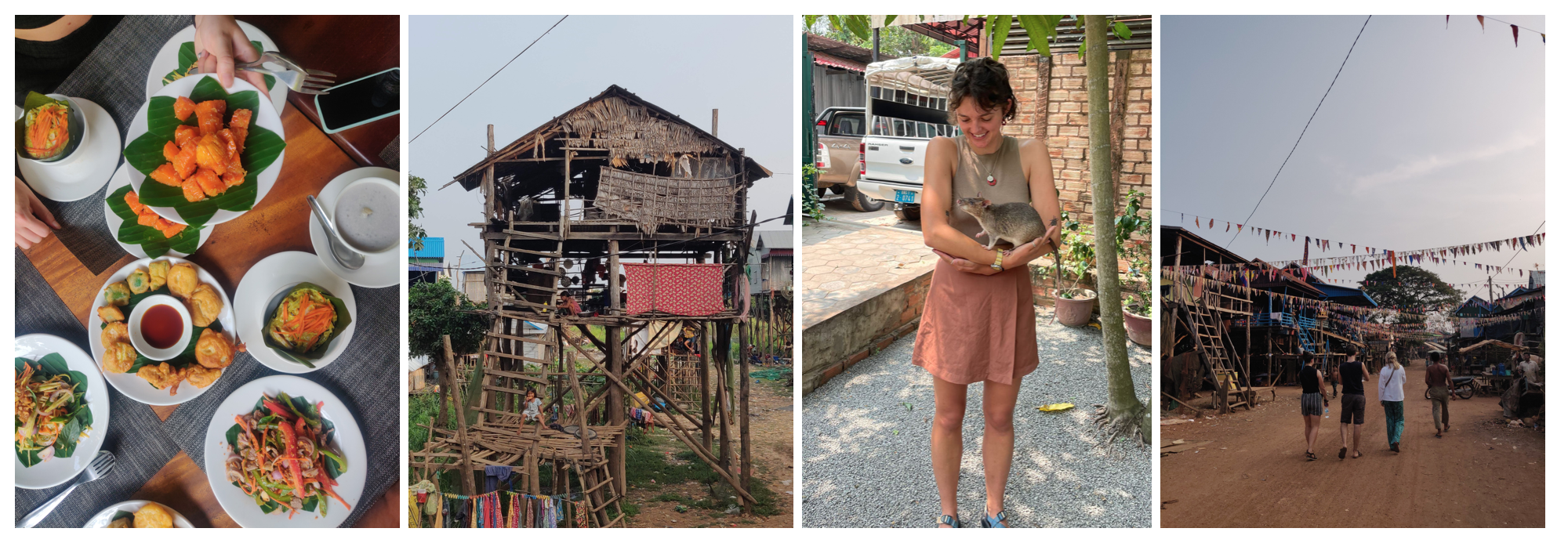
On our second day we visited the APOPO charity site which uses trained Pouched African rats to detect landmines, getting to watch the giant rats in action in a demonstration and hold the big guys. Cambodia has a huge number of leftover landmines from the crazy decades of history I’ve covered in a separate post, and these are continuing to injury people and prevent the use of valuable farmland. It was a strange but cool organisation to visit. In the afternoon we did a cooking class where we whipped up 4 Khmer dishes in record time. I’m not sure why exactly we were rushed through it at the speed we were, but it did add an element of adrenaline that was quite exciting. It did hinder being able to remember what we actually did however, so I’m not sure how faithful my recreations at home will be. An added bonus of the cooking class was going to the local wet market to pick up the produce. Watching the british girls’ reactions of fish being bludgeoned to death suddenly was quite entertaining. My personal highlight of Siem Reap was a trip to a floating village we arranged ourselves, convincing two others to join us. At this point I’d like to introduce Nathan (British) and Sarah (Canadian) who would feature across our time in Cambodia. We got a tuktuk for over an hour to the rural village along a river which fed into the Tonle Sap lake. It was dry season so the floating village was only floating on air, but this meant the stilts and height of the houses was available for inspection. Looking at the flimsy pieces of wood holding them up I’m not sure my Dad would have approved of the structural integrity of them, but they seemed to do the job. The homestay was more of a rustic boutique dorm room, with beds suspended from the ceiling on ropes and an uninterested family running it. Exploring the village was more fun, with every child wanting to talk to us and to high five us. They were full of excitement and it was hard to not catch some of it. We spent the evening trying to avoid being bitten to death by mosquitoes and playing cards. On our journey back to Siem Reap we asked the tuktuk to pull over at one of the hundreds of little stalls selling bamboo tubes being smoked over a fire, wanting to try one of them. The bamboo was filled with sticky coconut milk rice and soy beans, and it was delicious in the same way that coconut porridge with muesli is. So Siem Reap was packed to the rafters with activities, more than I’d usually do in 3 or 4 places combined! The change of pace in travelling style was a bit of a shock and definitely not one that could be sustained for too long. Luckily our next destination was all about relaxing…
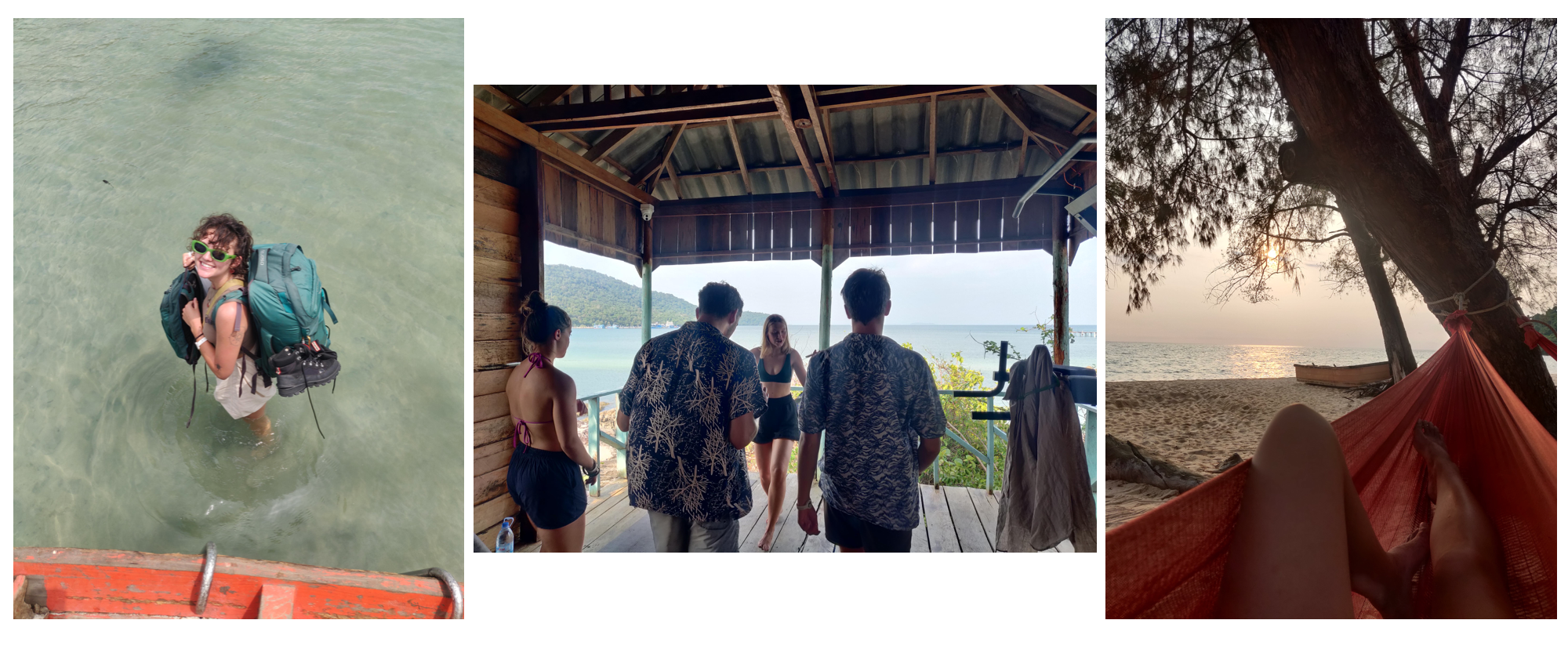
It had been almost 6 months since I’d seen the sea so I was seeping with excitement as I was crammed alongside Rosaline in the shared bed on the sleeper bus to the port town of Sihanoukville. From here a short ferry ride took us to the small island of Koh Rong Sanloem, and from the concrete jetty a little boat took us round to the next bay. There are no roads on the island so boat is the main way to get around. We hopped off the boat into water that was knee deep and held our bags clear, wading up to the white sand beach and towards the wooden huts scattered just past the tree line. This was the little hostel resort we’d be staying at for a few days, completely isolated from anything else. Definitely a unique hostel experience! We bed down in one of the small huts, shared with two aussie guys which I was extremely thankful for when two huge bugs appeared on my bed one day! Arriving extremely hot and sweaty we changed into our bikinis and immediately headed to the water for a refreshing dip. As we ran in we both slowed and let out a disappointed “oh”. The water was like a bath, insanely warm and in no way the cold dip we were hoping for. We spent two days relaxing, although in typical us fashion we somehow still remained busy. In our little gang with Nathan and Sarah, and some others we picked up, we did yoga led by me and a salsa class led by Rosaline. We swam a lot and read a lot and dozed a lot. In the evenings we also drank a lot, with Rosaline nailing the Karaoke night. There were lots of very nice people at the hostel, which was lucky since you were basically stuck with them! We took the free shuttle boat back round to the main bay one afternoon and trekked across the narrow island to the other side. With a view out west we were able to watch the sunset, or watch the sun go behind the low cloud. We walked with a group of us and played frisbee in the sea before each taking our own space to watch the sunset alone. I like it when that happens when travelling. When a group activity ends with everyone organically going to experience something alone, but together. I sat in a hammock listening to some music. Less tranquil was our journey back. The walk was fine, sweaty and mosquito heavy but balanced out by the several hornbills we saw. Back at the main bay it proved much harder than imagined to get a boat back to the hostel. Rosaline and I asked a man waiting and he offered to take two of us on the taxi boat he had called. Looking at the 6 others behind us I felt very guilty on taking him up on the offer, leaving them stranded on the pier, but they insisted we go! Everyone else did make it home safely, 3 of them were able to find a different taxi boat and the remaining 3 trekked through the jungle back, at night, with no headtorches, so I was understandably relieved when they arrived sweat covered back at the hostel! It was just the perfect island get away. The huts were basic and exactly what I was looking for. Couldn’t recommend more (it was Mad Monkey hostel)!
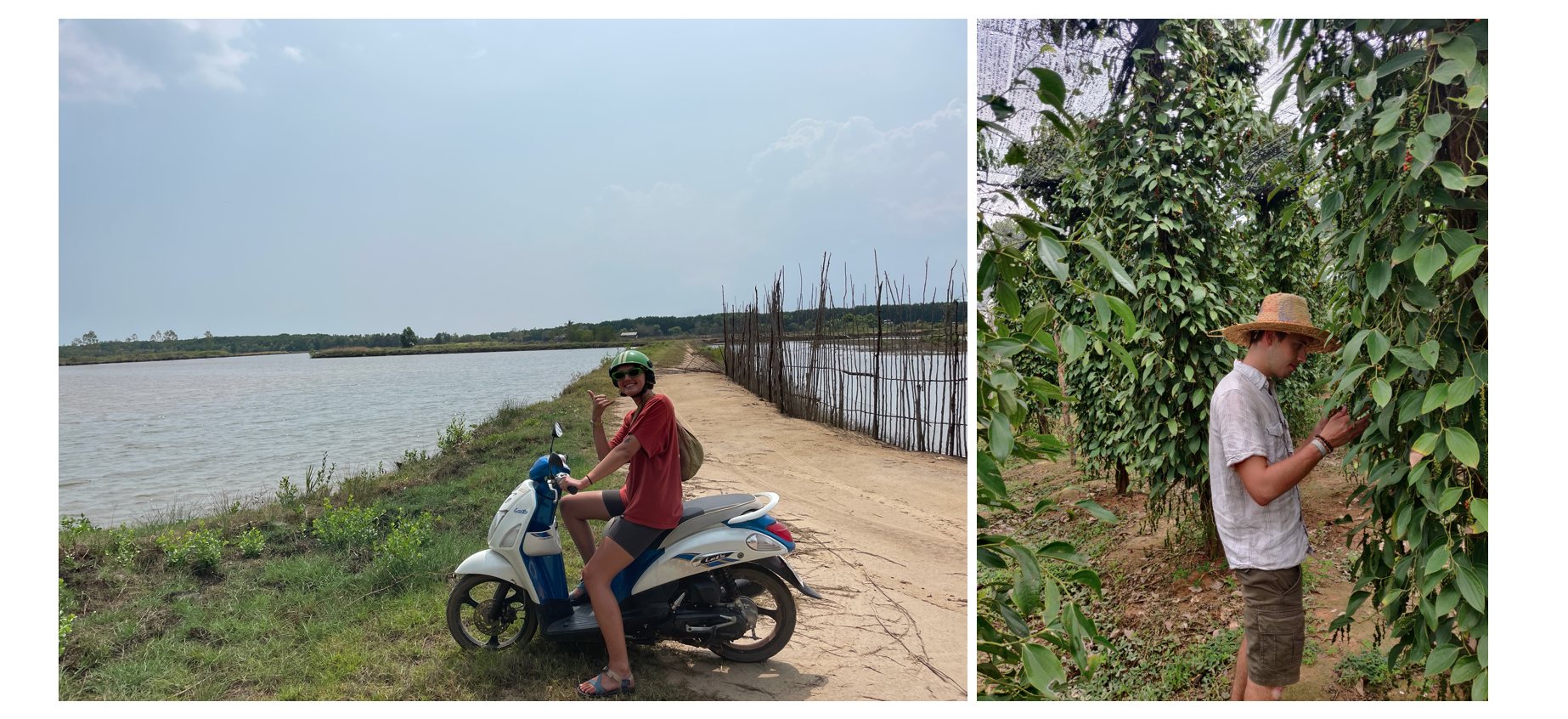
It was a short journey from the island to Kampot. The place itself was of a similar vibe to Siem Reap but a lot less touristy. Our hostel was once again lovely and with a nice pool. Kampot is famous for the Kampot pepper (of the salt and pepper variety) grown there, so of course we had to head to a pepper plantation to learn more about it. I had strangely high expectations for the plantation and, incredibly, they were exceeded. Set up by a French and Belgian couple the plantation serves as the best example of eco-social-tourism I’ve come across. They seem to have considered everything with its impact on the environment and the community and the overall experience as a visitor was just amazing. The tour and tasting were completely free too. One interesting titbit from the tour of the site is that, like with tea, all types of pepper (red, black, green, white) come from the exact same plant, what differs is the age and processing. The plantation was called ‘Le Plantation’ if you want to check it out! One afternoon I went for a stroll around the town alone, whilst Rosaline was busy with some work. As I was munching on the pork steamed bun I’d bought for lunch I came across two men playing a strange board game. They pulled up a chair for me to sit, providing some unexpected mealtime entertainment. I tried to grasp the rules of the game but to me it just seemed like chess with some different pieces that moved in slightly different ways. When the older man won comfortably in a frenzied end game I thanked them and said goodbye. A random highlight of Kampot for me was the insanely good breakfast we had one morning (I had a stacked breakfast bagel which was just to die for) which included a free round of mini golf!
After noticing how quiet and nice the roads were on our trip to the pepper plantation, I decided that this would be the perfect spot to try out a moped for the first time. I had tried to drive one once before whilst on holiday in Italy and it hadn’t gone well at all, but I felt a lot stronger and more capable than I was then. Powered by this confidence I paid the $4 hire fee for the afternoon, but was secretly relieved when he gave me the smallest of the mopeds parked up. With a helmet that was the same awful shade of green as my sunglasses I practiced going up and down the road a couple of times before deciding I felt great and could totally do this. Sarah had joined me and together we set off with no real aim. We reached a mangrove forest which we explored briefly, then we went our separate ways and I drove through small villages to a cave. I stopped at a train track that seemed so out of place, cutting through a dusty village with greenery lining either side, to watch a man and his son herd their cows. Overall, the first try of scooter riding went swimmingly and I was sad to hand the keys back. I’m looking forward to doing lots more in Vietnam…
A short 4 hour bus journey brought us to our final stop in Cambodia, the capital Phnom Penh. When I woke up from my nap on the bus to see the city for the first time I couldn’t believe my eyes. The rural, developing countryside that had been outside of the window the whole time was suddenly flashy glass buildings, huge lit up signs, showrooms of every brand of fancy car in existence. It wasn’t tacky nor shabby. It was all squeaky clean and brand new looking. I felt viscerally shocked in way I had never experienced when entering a new place. Looking at the view from the hostel rooftop it was a skyline of skyscrapers and lights. It could’ve been London if London was clean and all of the buildings were new. Exploring the next day it was confrontational; the way the people lived and the city they lived in. The developing lifestyle remained, huge markets where people squatted down, cutting up fruit or bamboo, rubbish everywhere. But beyond the street, the glass skyscrapers were visible. Never have I seen a city where the architecture and the life within are so contrasting. These new skyscrapers were clearly not built by or for Cambodian people. Walking around the streets by our hostel in search of dinner we had a new shock when it dawned on us we were in the red light district. Plastic chairs were set up in rows outside of bars, arranged like in a school assembly, with girls sat on them. It was so strange and picturing someone going into the rows to pick a girl seemed even stranger. If you can’t tell from my description, Phnom Penh was not my favourite place. I found it an incredibly strange city and not a particularly pleasant one. We visited the Genocide museum and the Killing Fields here, but I’ve discussed these in the post about Cambodian History. From here we caught a very comfortable bus to Ho Chi Minh in Vietnam, going through another easy border.
Main dishes:
And then lots of fried rice, fried noodles, fried veg. Overall, a little bland and nothing too special. Surprisingly, not spicy at all. I can see why Thai and Vietnamese food overshadow it.
As a lover of Russian history because of its insanely ruthless leaders, strange ideological plans, and pure chaos, I held it as the most prominent example of all of these things in history. Then I started to research Cambodian history. How wrong I was. I have never come across a history as messy and unbelievable as theirs, including a period of absolute terror to the likes I couldn’t even imagine before. Yes I’d been vaguely familiar with the Khmer Rouge and had watched the film ‘First they killed my Father’, but I did not comprehend the full atrocities which took place. Nor did I have any idea of what came before or after. Learning, and hopefully understanding, history like this is one of the most valuable aspects of travel for me. After visiting the Killing Fields and Genocide museum I felt like I needed to write the history down so I didn’t forget it. I also want to share it here as it’s a slice of history I think we should be more than just vaguely aware of.
From 1863 to 1953 Cambodia is ruled by France, like neighbours Laos and Vietnam. In 1941 Sihanouk (a Khmer (the main ethnicity in Cambodia)) becomes King but is still under France’s control. In 1953 Cambodia gains independence and King Sihanouk becomes King in more than just name. Under pressure to introduce democracy, Sihanouk abdicates the throne so he can run in the election, which he then wins becoming Prime Minister (with a healthy amount of election fraud and voter intimidation). In 1960, Sihanouk cements his position and becomes the permanent head of state. His rule is brutal; communist revolutionaries are sought out and executed, the farming peasants are neglected and suffer. In 1969, the US begins a secret bombing campaign within its war against Vietnam where it carpet bombs Cambodia in Operation Breakfast (followed by Operation Lunch, Snack, Dinner, Supper and Dessert) under Nixon’s ‘Madman theory’, aiming to show Vietnam he’s irrational and volatile and therefore should not be messed with. Sihanouk doesn’t do anything in response to this, choosing to remain quiet rather than anger the US. The country simply isn’t doing well, creating the perfect landscape for the Prime Minister Lon Nol to overthrow Sihanouk in a coup in 1970.
From 1970 to 1975 civil war ensues across Cambodia. Lon Nol sends the Cambodian army to fight the North Vietnamese who are hiding out in Cambodia. A communist guerrilla movement, which will become known as the Khmer Rouge (officially the Communist Party of Kampuchea), fights against Lon Nol and as does the North Vietnamese. So called Liberated Zones are under the Khmer Rouge’s control, and these expand until finally Phnom Penh (the capital city) falls in 1975 on April 16th. This day begins with relief. The population in the city are thankful that the years of civil war and the terror that came before that are over. This feeling is incredibly short-lived.
On April 16th 1975, referred to as Year 0, Phnom Penh and the other cities in Cambodia are forcefully evacuated. People are told they have to leave for their own safety as more US bombs will be dropped on the city. This is a lie. The reason for the evacuation is completely absurd. The Khmer Rouge is a communist group led by Saloth Sar, better known as Pol Pot, which holds an ideology rooted in Maoist communism. Under Marxist-Leninist communism, the one I’m familiar with from my Soviet Union studies, the focus is on the proletariats which are the industrial working class. Under Maoism, the focus is on the agricultural peasants as the countries it applies to have not yet had an industrial revolution. Pol Pot took this to the extreme, considering peasants to be the epitome of the world and viewing agriculture as the pathway to Cambodia’s success. The Khmer Rouge’s plan was to make Cambodia self-sufficient in food production to remove any reliance on neighbouring countries, eventually allowing it to export food for money and elevate it to international success. I can see the logic in this plan. Where any logic stops is on how this would be achieved. Pol Pot’s grand scheme was to force everyone to become farmers and collectivise the farms. There are some obvious flaws here, not going into details but people from the city had no experience as farmers and collectivised farms failed miserably in the Soviet Union (see my post on Gori for more on that). In addition to these issues, the overall conditions under the regime destroyed any chance of success. People were stripped of everything - physical items, communities (families were separated), decisions over their lives (the state chose who you would marry, often pairing old men with young girls), sense of self (it became illegal to say “I”, being replaced with “we”), human decency (the mass graves at so called Killing Fields speak for themselves). People were forced to work 19 hour days, digging irrigation channels or planting rice, on one or two bowls of rice water. People starved to death. People, including children, were tortured and killed for foraging for extra food. Unsurprisingly, these conditions did not deliver the tripling of rice yields Pol Pot wanted. Just as in the Soviet Union, the guards on the ground didn’t want to admit failure so inflated the figures, meaning more rice was taken from each community for export leaving even less for the people. This cycled into famines and even lower yields. If this everyday life isn’t nightmarish enough, Pol Pot was paranoid and was purging the country ferociously. The main targets were a group known as the “New people”, referring to city-dwellers and educated people. This included anyone who wore glasses, could read or had soft hands. Monks, nuns and minority ethnicities were also targeted. These people were gathered up in places called prisons but I think torture death chambers is a better descriptor. We visited the most famous of these in Phnom Penh, S-21, now a museum. Here the level of atrocities a human can commit to another human exceeded my understanding of the world. I can not comprehend the acts committed under the Khmer Rouge, both in their horror and their reasoning. Men, women and children were taken to these prisons and confessions were tortured out of them. They were then taken to Killing Fields where they were executed and thrown into mass graves. In the one prison we visited, 12,000 - 20,000 people were tortured there. There are 12 known survivors. It is unbelievable. I won’t go into the forms of torture used, but I will say that bullets were not used for the executions as they were too expensive and guns too loud. Instead, the people would be beaten to death using any tools available. This is not simply a genocide of lives, it is a genocide of entire human nature extending to those killed and those killing. The reason for the deaths and the torture? I can’t tell you because there really seems to be no explanation. I suppose these people killed because they could possibly threaten the regime. But could so many children, women and just normal people really pose a threat? The confessions forced out of them were often to do with the CIA, or spies from the Soviet Union or China, completely random things. Some of the slogans of the Khmer Rouge may help to explain the lack of reasoning:
“To keep you is no gain; to kill you is no loss”
”It is better to kill an innocent by mistake than spare an enemy by mistake”
”To dig up the grass, one must remove even the roots” (referring to killing an entire family if one member is seen as bad).
Perhaps the uneducated, brainwashed nature of the guards offers an explanation. They were often young peasant boys taken from their villages. On one wall in the prison a guard had been asked to write numbers for the keys to different cells. Clearly unable to write numbers, he scratched lines into the wall until someone who was able to write took over. This was the level of education of the majority of people wielding power.
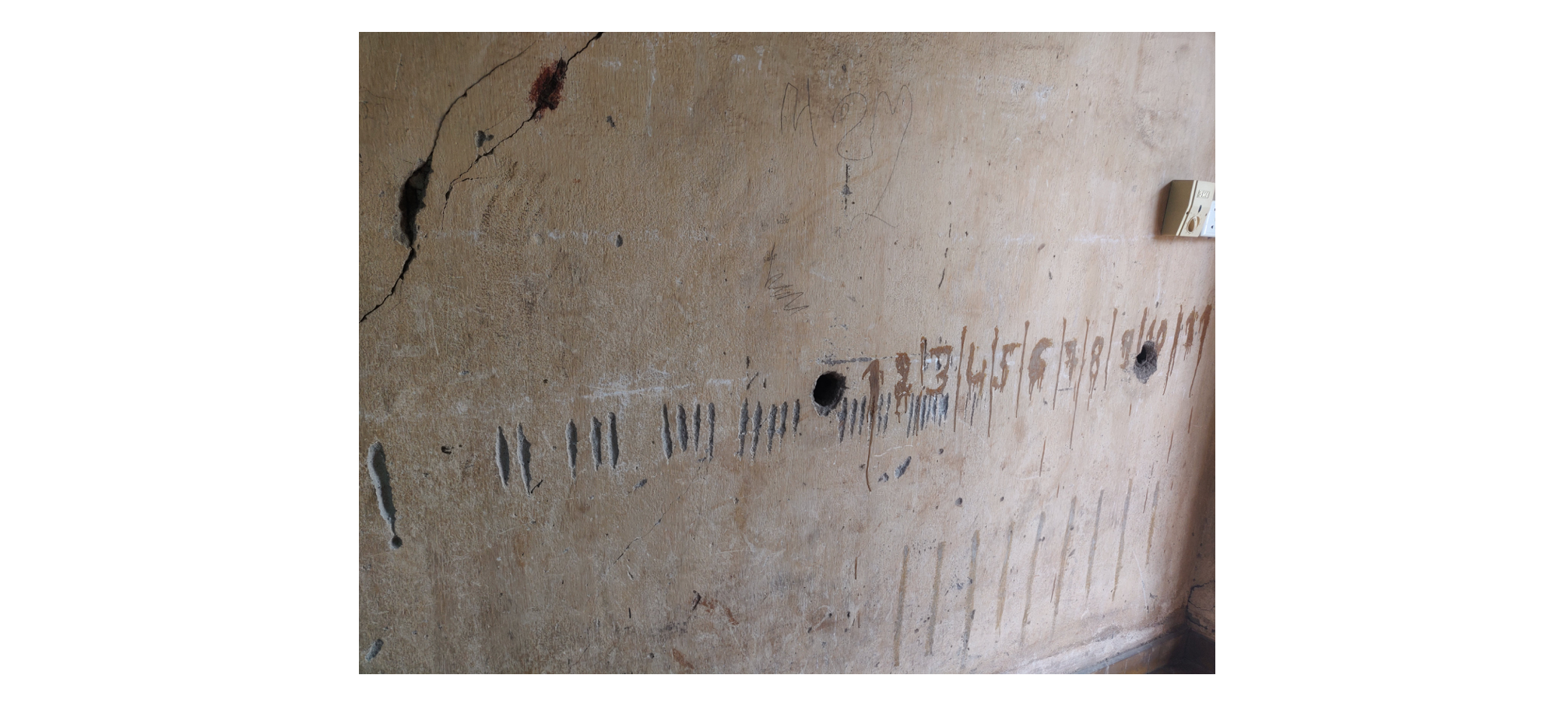
Whilst this was all under Pol Pot’s control, he was not the face of the Khmer Rouge. Most people did not even know his name. The head of state at this point is, surprisingly, Sihanouk. Yes you’re remembering correctly, he was the King turn Prime Minister turn head of state who fought against the communist groups. Once he was overthrown he declared his allegiance with the Khmer Rouge in a one-sided manner, but the Khmer Rouge saw the benefit of his fame and relative popularity and went along with it. When the Khmer Rouge took power he was made to be the face but basically placed under house arrest in the Royal Palace with no control. In 1976, even Sihanouk is appalled by what’s happening under the regime and he resigns, escaping the country. Begrudgingly, Pol Pot becomes Prime Minister. By 1977 the country was deteriorating and it was evident that Pol Pot’s plan was an absolute failure. To distract from this, or to provide a scapegoat for the failure, Pol Pot orders an attack on the Vietnamese border. In 1978 Vietnamese forces invade Cambodia and by 1979 they have taken over the capital and the country. Slowly the insanity of the Khmer Rouge regime is unpicked and elements of normal life are re-established.
As I mentioned at the start of this post, the overall history of the 20th century in Cambodia is just crazy, and it doesn’t end with the Khmer Rouge being chased out of Cambodia by the Vietnamese. In 1981 there is an election and the pro-Vietnamese party wins. However, the international community (including the UK, the US, France and Germany) refuses to recognise this new government as they are viewed as invaders, preferring to recognise the Khmer Rouge as the rightful leaders of Cambodia. The Khmer Rouge retains its seat at the United Nations. During the regime Cambodia was isolated as much as possible; there were no telephones or TV or open borders. Perhaps it’s plausible that the international community didn’t know what was happening, although the isolation itself would be an indicator of something sour. After the regime fell I do not think it’s possible that the international community was not then aware of what happened, especially with Sihanouk escaping and letting people know. So why on earth the world backed the Khmer Rouge as the legitimate leaders I have no clue. Like I said, just crazy. In 1989 Vietnamese troops withdraw and Hun Sen is Prime Minister. One guy who just won’t go away returns for a final time, and in 1991 Sihanouk is once again made head of state, and then King when the monarchy is restored in 1993. We’ll leave the history there.
The Khmer Rouge is the worst regime I have ever come across. In the 3 years, 8 months and 20 days of their control, 1/4 of the Cambodian population died. It was ideologically senseless. Pol Pot lived a happy and comfortable life, living the last two years under house arrest before dying in his home (a heart attack, but perhaps not naturally occurring with some believing he may have taken his own life or was poisoned). In 2007, a UN-backed tribunal finally begins against the remaining Khmer Rouge high ranking officials, seeking justice for the genocide. Most of them are already dead or too unwell to face trial at this point. Only three of them are ever convicted. To me, it does not seem like justice was served. The fact this regime is bookended by an authoritarian regime, secret US bombing, a civil war, and an invasion makes the whole period unbelievably depressing but also interesting. The Khmer Rouge seem to overshadow the atrocities under Sihanouk’s first regime, allowing him to return over and over again. There is still a town called Sihanoukville and his popularity never seemed to dip too low. If you want to learn more about this history I would really recommend the four podcast episodes on Pol Pot by Real Dictators, and also the film ‘First they killed my Father’.
Entering Cambodia I was still learning about this history. But if I wasn’t listening to podcasts and reading about it, it would not have been on my mind at all. There is nothing to bring this very recent, very traumatic history to your attention. I saw no memorials. There was no talk of it with my interactions with local people, nor with other travellers. The country seemed to have chosen a sweep it under the carpet and forget about it approach. I can’t blame them. But knowing that every person you see has a connection to the history is shattering. The collective trauma of the nation seems unspoken about. Like daring to admit its existence would be a huge sin. I asked our tuktuk driver on the way to the Killing Fields if he had ever visited himself. He said maybe with school, but he couldn’t remember the history. I haven’t met anyone who wanted to talk about it openly, and never felt comfortable pushing the topic. I don’t understand the attitudes towards the past in Cambodia, we haven’t spent long enough here nor in the right places to even attempt to. I think only speaking english would also be a barrier. I wish I could find out more about how the Khmer Rouge affected people and continues to affect them, and about their attitudes on the wild character of Sihanouk. On a base level, visiting the Killing Fields and the S-21 Prison suffices. They both have excellent audio guides and are very respectfully and carefully curated. I am sad that other travellers did not always seem aware of the history, but perhaps it’s because Phnom Penh is often the last stop on people’s Cambodia trip and they will only learn about it here. Or because the demographic is more gap yearers in search of beers and beaches than history, unlike the Balkans which is the last comparable place I have been to in terms of history. Cambodia holds the most painful and horrific history I have come across, never before have I seen a country-wide experiment with civilisation like under the Khmer Rouge. I hope its closed rather than open attitude towards the past does not cause issue in the future, but I worry it might.
After keeping a casual eye on the situation in Myanmar and my deadline to reach Bangkok I caved and took a flight from Kathmandu to Bangkok. I know I know, this one I’m a little ashamed of because since looking into it more carefully, I think it would be possible to visit Myanmar right now, with the UK government website just being overly cautious. I really wanted to visit Myanmar, to understand the transition from India to Thailand in terms of culture and especially food. Is this a travel regret? Yes, absolutely. I feel like I took the easy option and should have tried harder to cross overland from India to Thailand. But I had already arranged to meet a friend in Bangkok and was running out of time in general on my trip, so here we are. Perhaps I’ll go back, maybe some other time, maybe on this trip… Anyway, moving on to the here and now, I landed in Bangkok and underwent the biggest culture shock of my life. I hadn’t realised how used to the developing country situation I had become until I was driving along a huge elevated road, surrounded by skyscrapers and shopping malls, my eyes almost falling out of my skull and a continuous drivel of “I can’t believe how modern this is” out of my mouth. My distant family relative who had picked me up from the airport kept glancing at me like I was mad. This judgment deepened when he dropped me off to his spare apartment where I’d be staying and I exclaimed repeatedly at how amazing it was. To my now adjusted eyes, it was just a normal, nice apartment. But to the eyes that had spent the last few months using squat toilets in sheds, it was pure luxury. That first night in Thailand, Isada (my distant relative) took me out for dinner with his girlfriend. Over a wonderful feast in the traditional Thai way (lots of dishes ordered for the table and shared) we worked out how exactly we were related: my grandpa’s cousin is his grandma’s brother. I did some life admin the following day - washing my underwear in the sink, getting a sim card, using the apartment’s gym - before going out with Isada to celebrate the Thai New Year or Songkran. This saw the streets explode into a city-wide water fight. Water was thrown on you or shot at you from water pistols from every angle, especially when walking down the main party street in the centre. Riding in a tuktuk you were a sitting duck, especially at traffic lights. It was absolutely insane. I did make the mistake of wearing a pink top I’d bought for about £1 in India with my cream shorts, and the dye from the top bled all over them creating the strangest look. Sadly I have no photos from Songkran for the obvious reason that water was everywhere and I’ve already lost one phone to water damage!
The following day I returned to the airport to pick up a very special guest. A returning character to the travels of Meg the Rolling Egg if you will. Rosaline! Clearly not put off by the 2 weeks we spent in the Balkans together right back at month 2 of the trip, she had decided to come and join me for 6 weeks in Southeast Asia. So for now it’s goodbye solo travelling, hello travelling as a pair. After my post-hike slump shaking up the vibe by no longer travelling alone is definitely something that has its benefits! I was extremely excited to see Rosaline after not seeing anyone from home for so long, but I was also a little apprehensive. I was so used to this slightly new version of myself I’d developed into whilst travelling, I didn’t know how it would feel to be back around someone who knew the me from before. This isn’t to say I think I’ve changed whilst travelling, but I have settled into a slightly newer form. How would our relationship be after not seeing each other for so long? And what would that mean for all of my other relationships with people at home? Luckily, as always, there was no need to worry and it was the perfect balance of reuniting with an old friend and celebrating how we’ve both grown since we last saw one another. We spent several days in Bangkok celebrating Songkran, eating amazing food (including pad thai of course), having a thai massage, and falling for what was most probably a tourist scam boat cruise but one we enjoyed nonetheless.
Bangkok was a metropolis. The outskirts were filled with glass skyscrapers and the biggest malls I’d ever seen. The centre had wide streets filled with tuktuks and cars and mopeds, impressive temples and palaces dotted around and a river snaking through. There were pavements, something I’d missed in India and Nepal. You could walk around and explore quite happily, a part from the humidity and heat which left you soaked in sweat after 15 minutes. The street vendors were plentiful but the vibe was different to India and Nepal. Nepal vendors were my favourite still. But the food here, I think it wins it. Maybe I’m just tired of Indian food, but I was in love with the Thai cuisine. It tasted so fresh, with so many salads on offer, and with so many flavours in one dish. Indian food seemed heavy and simple in comparison. The people in Bangkok were amazing. You’d think huge crowds drinking and throwing water at each other would invite some unsavoury behaviour. We were body to body with people frequently in the crowd, all soaking wet. Neither Rosaline nor I experienced any inappropriate behaviour, nor did we see or hear of any. It’s a low bar, but one that I highly doubt would have been reached in London! People were very respectful, often asking before they splashed water on you if you weren’t on the crazy main street. I didn’t love Bangkok but that’s because it’s a huge, slightly impersonal feeling city and I’m not a fan of those. I wouldn’t rush back, but I didn’t hate it!
Rosaline and I had done very little planning for our 6 weeks, having just a rough idea that we’d go up to north Thailand and into Laos, crossing to North Vietnam and down to Cambodia (maybe a bit ambitious for the 6 weeks Rosaline has but hey ho). On her arrival we rethought all of this because of a festival Rosaline wanted to visit in Hoi An, so we instead made way for Siem Reap in Cambodia. It had been a very short introduction to Thailand but I’d be back for more!
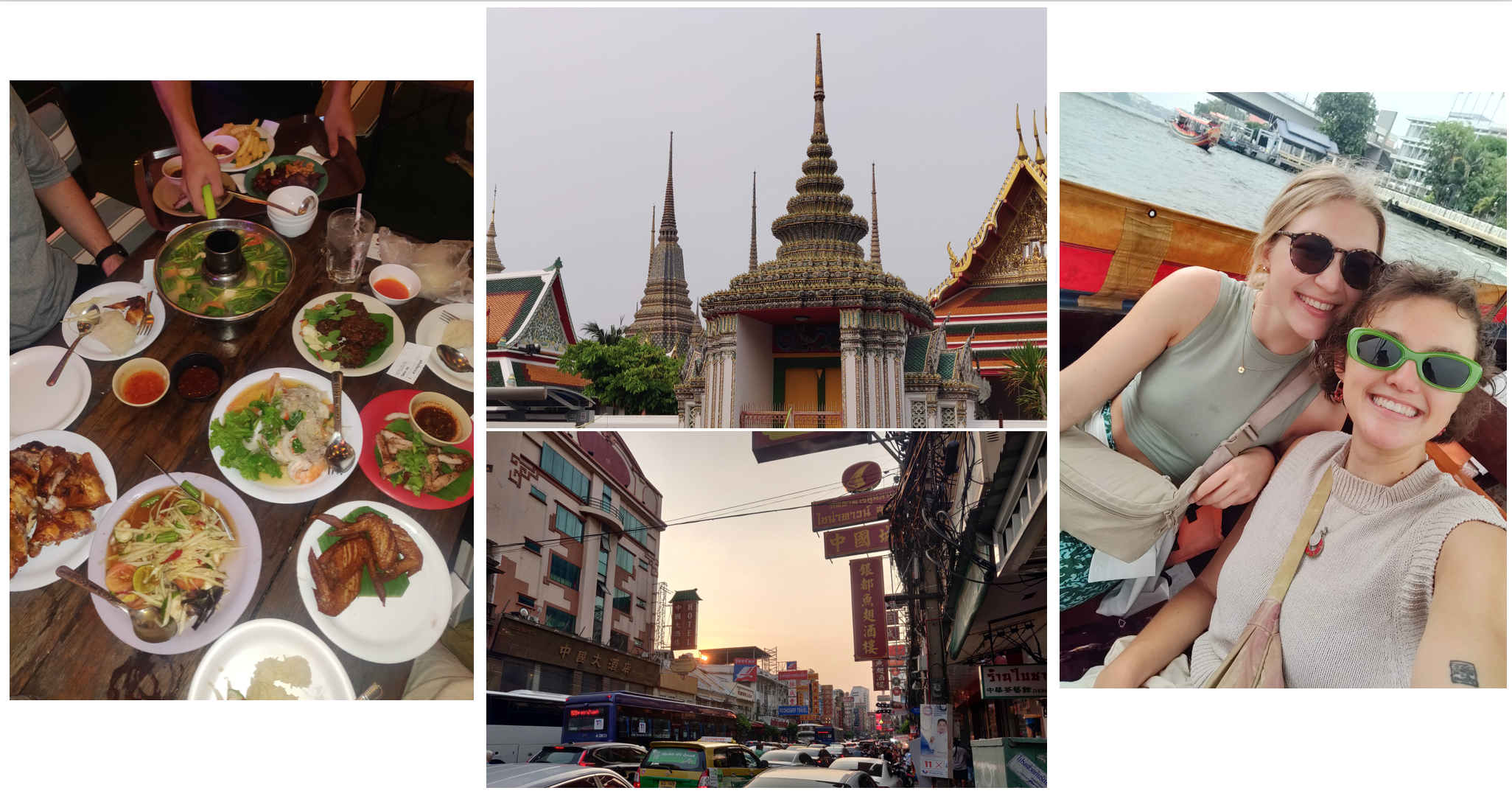
Nepal was one of the countries on my route plan that I was really excited for and had plans for. I knew I wanted to hike there, and I wanted to do a workaway there. I don’t know why, but I felt drawn to it and had a feeling I would really like it.
I crossed the land border at Sonali from India into Nepal. It was an archaic and slightly frustrating experience which involved hunting around for the border offices (the one to exit India was in the corner of a hotel car park, the visa office for Nepal was hidden behind a shop and restaurant), and walking long distances between them. For the Nepali visa you needed to have two passport photos with you, and the correct amount of money in US dollars. I had the fun of trying to secure both of these items in Varanasi, which took the best part of a day. The border officials were useless and annoying. Luckily I wasn’t alone being with Mary, Leonie and Sam who I’d met in Varanasi. Eventually we all gripped our approved visas and had managed to find a bus that would take us to Chitwan National Park. This was my introduction to Nepali buses and it struck fear into my heart. The roads were by far the worst I’d ever encountered. We were sat in the driver’s cabin, on a bench squeezed between 6 Nepali people where personal space was a distant concept. The old lady used my back as an armrest when, on hour 5 of the journey, I bent over my own legs to try and nap a bit. This meant I was trapped in that position until I gathered the courage to shrug her off. The journey took 7 hours in total but felt a lot longer.
I spent 3 nights here with Mary, Leonie and Sam. On our first day we hired bikes and cycled without direction around the area, taking in the bridges over the wide river, the people working in rice paddies, the beautifully tiled houses, the random of animals everywhere. It was very pleasant, although the bikes were all terrible. In the evening we walked into the town centre for dinner and stumbled across a rhino in the street! It marched down the road with such sass and confidence. We hid behind a fence when it passed us. It was a one-horned rhino which is native to Nepal, something everyone at home seemed shocked by. The following day we actually entered the national park, although after the close rhino encounter we’d already had it seemed like we’d peaked early. This was correct. The first 30 minutes was spent floating in a wooden canoe down the river, where we saw a huge number of incredible birds and several crocodiles. The next 10.5 hours (they weren’t joking when they said it would be a full day!) were spent trapsing around the park on foot. It was very hot and humid and dusty. We didn’t see anything mind-blowing, lots of deer, some distant rhinos, elephants in captivity. The highlight for me was seeing a tiger pawprint and tiger poo. After 9 hours you could feel the fatigue amongst us, with us joking about how unbothered we were by yet another rhino. It was cool to walk through the different habitats, often not on any sort of path, fighting our way through jungle one minute, then crossing open flatlands the next.
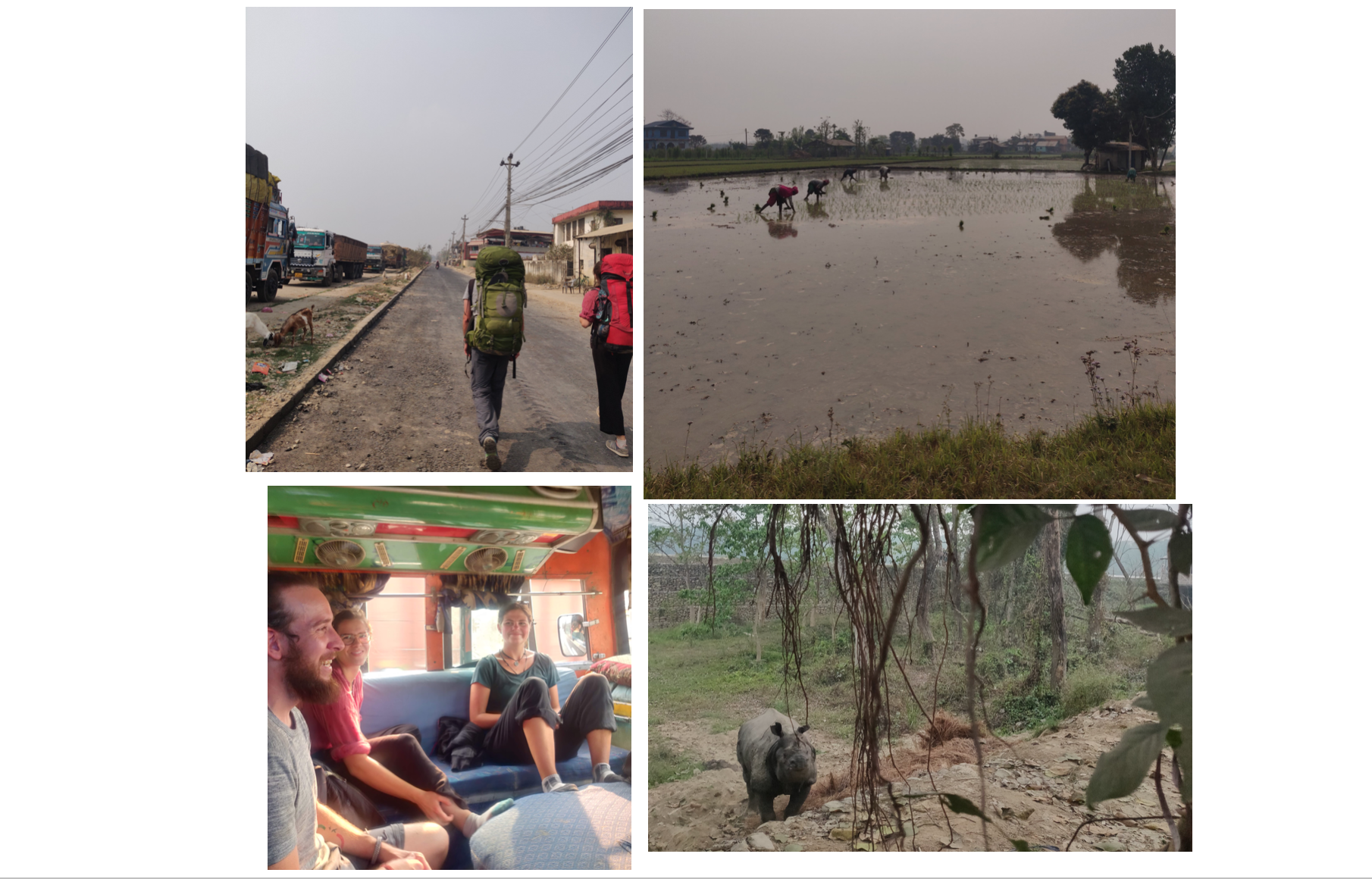
A typically awful bus journey took 6 hours to transport us to Pokhara. I spent a few days here before heading off to trek in the Annapurna region of the Himalayas (there’s a separate blog post on this). Time was mostly spent preparing for this, but on the 6th March it was Holi! The hostel organised a Holi party to start the day off and ensure we were sufficiently covered in coloured powder before we set off into the main town where we paraded down the main street up to where there was a stage with a DJ. Whilst there were locals taking part in the celebrations, lots of them just watched on with bemusement as all of the tourists were marched down the street. It was like a mini festival at the stage, with the DJ being followed by a live band who were actually quite good. The mixture of western and nepalese music kept it fresh. We danced, drank beers, and continued to get covered in coloured powder, glitter and water. The atmosphere was great, everyone was in a brilliant mood. Feeling suitably day drunk I returned to the hostel before the crowds descended so I could shower clean, no small task when you’re completely covered in powder! The next morning I left the hostel at 5:30am for the bus to begin my trek.
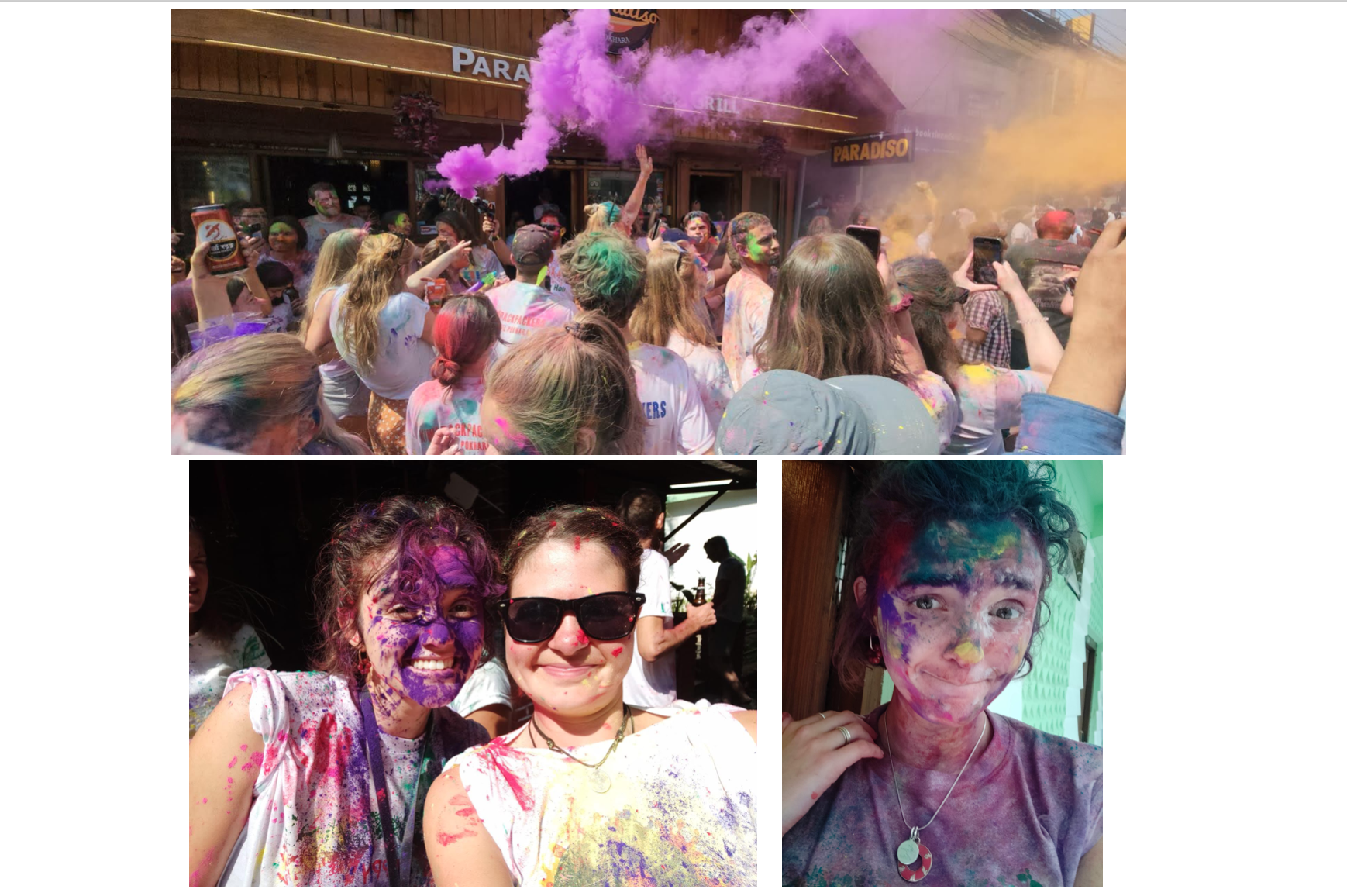
On my return to Pokhara, I realised that a friend from university (Uma) was currently also in Pokhara! Neither of us could really believe it, and it was as strange as it was wonderful to meet up with her for a crepe and a beer. A really lovely surprise, the first time I’d seen someone from home since my brother left me in Istanbul in September. Other wonderful experiences included taking a very long, hot shower after trekking and washing all of my clothes; enjoying huge salads at the infamous Veganway restaurant; going to an outdoor cinema to watch Inglorious Basterds in the pouring rain; getting up to watch the sunrise over the lake from a viewpoint and take in the mountains that surrounded the town. I did a momo cooking class with two other guys, being humbled by just how difficult it was to fold the precious little dumplings. Momos are Tibetan dumplings and are found everywhere in Nepal. We made 110 momos and I’d like to think my folding technique did improve by the end. I enjoyed eating them even more than making them. A much less wonderful experience was contracting a second round of gastro that saw me almost faint on the bathroom floor. Why I thought I was invincible to the sickness when everyone at the hostel was falling victim to it I don’t know. I could have easily just moved hostels and avoided it! Luckily this aggressive vomiting and diarrhoea only lasted 8 hours, and I made a miraculously quick recovery as I took the gamble and still caught an overnight bus the next day. This bus delivered me to the east of the country where I did a workaway on a tea farm for 10 days (there’s a separate blog post on this).
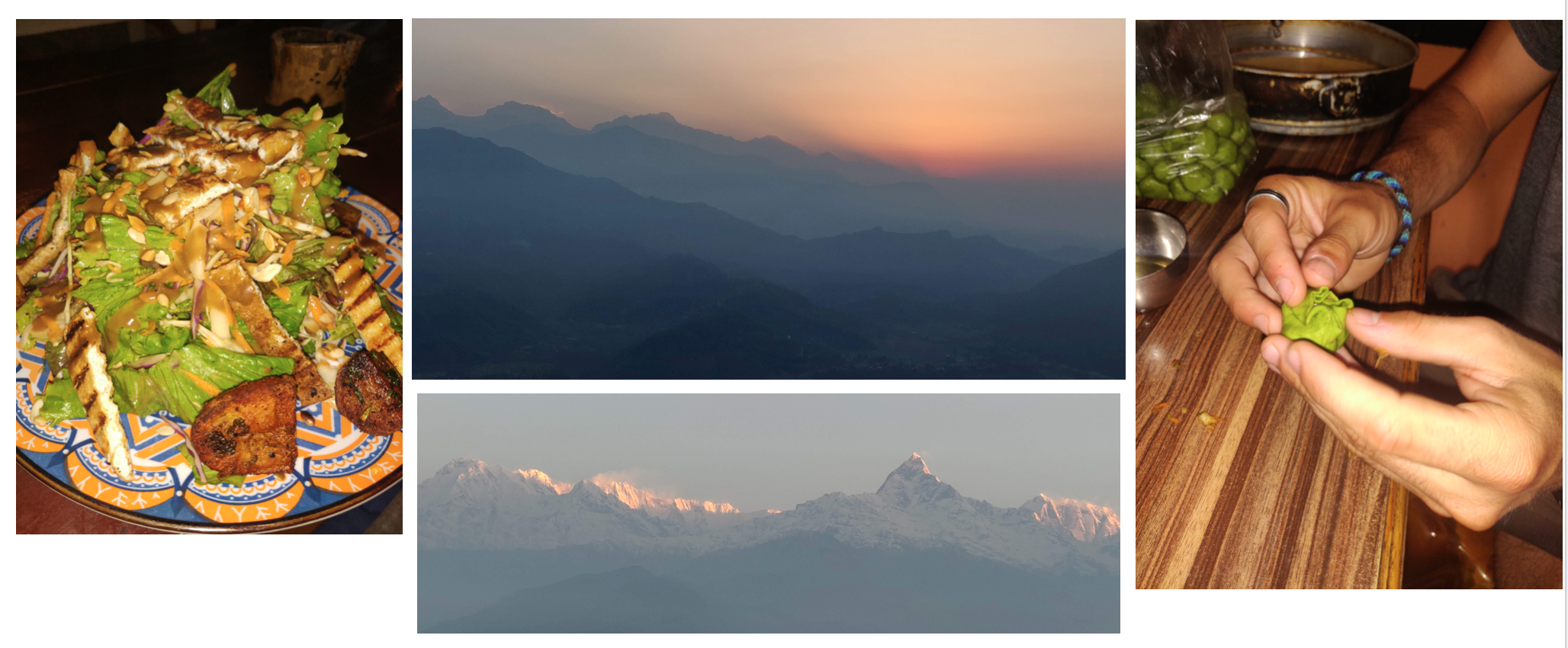
Unusually, my last stop in Nepal was to the capital. It felt like I was doing it backwards, but it was nice to have already experienced ‘real’ Nepal before hitting the big city. The journey here was the most excruciating yet. I had to leave the tea farm at 4:30am to walk the one hour along country lanes to reach the nearest town where I caught the bus at 6am - who’d have thought my headtorch would come in handy again! The bus took 15 hours and I was crammed against a man sat on a stool in the aisle the entire time. One saving grace on Nepali bus journeys are the food stops. They’re always at dodgy looking roadside restaurants in the middle of nowhere, but you’re guaranteed a delicious meal. On this mammoth journey I enjoyed a chana (chickpea) salad for breakfast, a very tasty dal bhat for lunch (the only thing being served), and a plate of fruit covered in spices as we waited for the brakes or the tyre on the bus to be fixed (I’m unsure what exactly was the problem). At 9pm I made it to the capital, and a helpful man on the bus had sorted me a taxi to my hostel before I’d even pulled my rucksack from where it was secured to the roof.
People had reported that Kathmandu was crazy busy and dirty, but I think once you’ve been to Delhi you’re tolerance for this is extremely high because I found it to be fine! I visited the Swoyambhu temple complex, the most famous attraction in the city, in the morning and found it pretty impressive in its size and atmosphere. It was interesting to see both Buddhist and Hindu buildings besides one another, with it being a significant site for both religions. It’s colloquially known as the Monkey Temple, and I can confirm there were a lot of monkeys there. I visited the Durbar square in Kathmandu at dusk and took in the huge temples and massive old buildings. It was the first time I’d seen Nepali city architecture and I really liked it. I zipped down Freak Street, the old main hippie street from the hippie trail back in the 60s. This was less nice! I finally got to try some Newari food. Newari is one ethnicity in Nepal and they are famed to have the best cuisine. They’re located in the Kathmandu valley hence why I hadn’t tried any of their food so far. It was very different to the dal bhat I’d gotten used to eating. Much more meat heavy, with buff featuring heavily, and the spice blends creating a whole different palate. The star of the show was definitely the yomari filled with a dark and bitter chocolate and coconut paste, just delicious! I only had one day in Kathmandu which was definitely not enough time. I also had several adminy tasks to do before I headed off to my next country. I sold my remaining warm clothes after selling most of them already in Pokhara to other trekkers (won’t be needing those anymore!) and had an especially traumatic haircut. If I ever come back to Nepal (I absolutely plan on it!) my first stop will have to be Kathmandu so I wasn’t too worried about seeing everything.
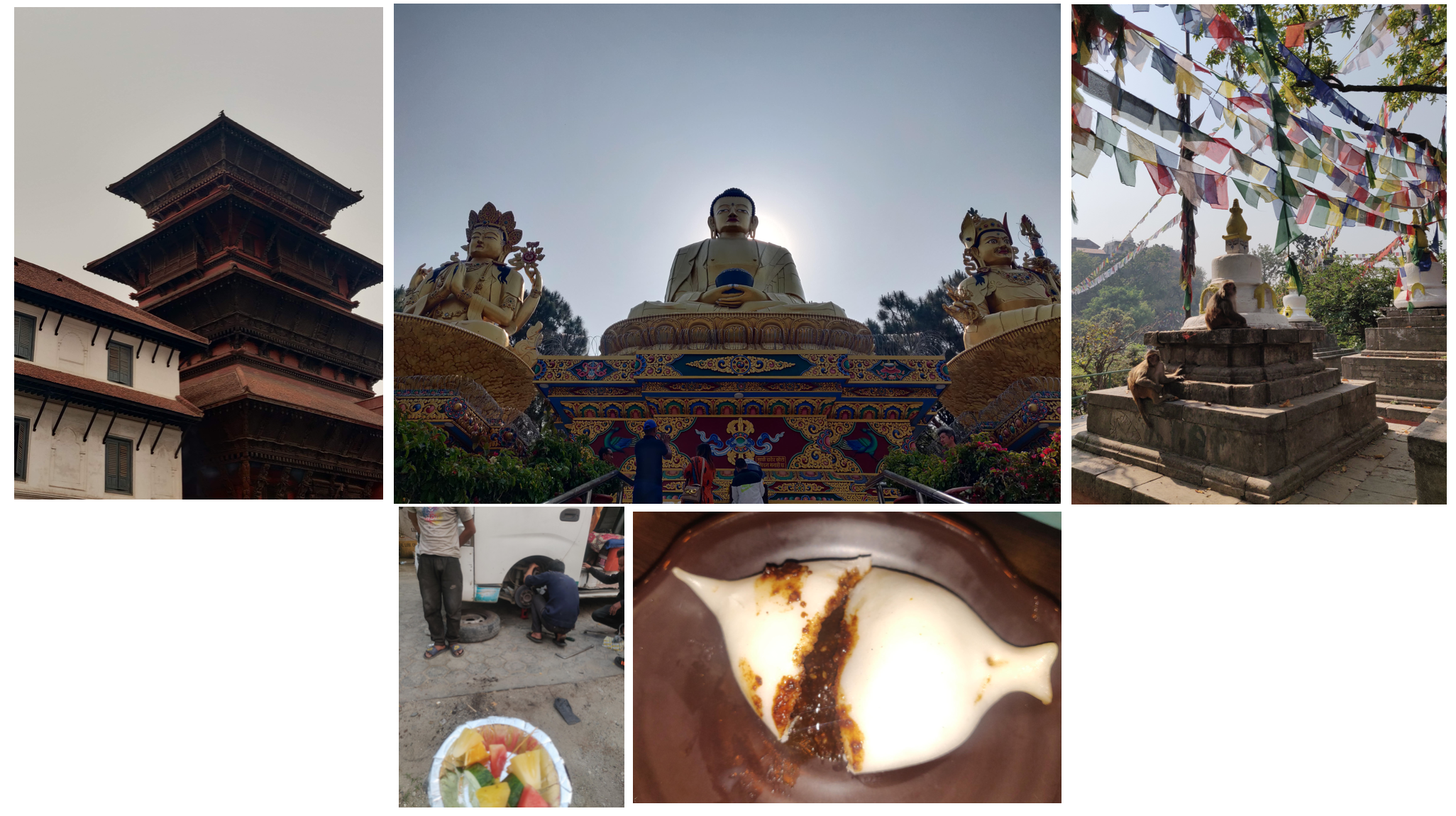
Three random things I loved about Nepal:
Three random things I did not love about Nepal:
I felt a strange draw to Nepal before this trip so knew I wanted to experience the real country beyond the trekking. As someone who loves tea, and who loves biology, volunteering at a tea farm seemed like the perfect opportunity to do this. After a few days in Pokhara to rest, get violently sick and recover, I caught a 16 hour overnight bus to a city called Birtamode in the very east of the country. I was feverish on the bus but luckily kept control of my bowels. This left me completely exhausted when I reached Birtamode, and I took my time before catching a jeep a further hour to a town called Fikkal. From here I walked 45 minutes across hills covered in terraces of tea bushes and well-kept houses to the Kulang’s family farm. I spent the next 10 days here, along with a slightly changing gang of 5 - 7 other volunteers, who happened to all be female.
The farm was simple but practical. It served as a good reminder of how much we take for granted in modern life. I didn’t actually notice the lack of modern amenities at first, so I guess it also showed me how flexible I’ve become to different living situations. There was no hot water, no proper mattresses, no sinks. There was no oven or fridge in the kitchen. Food was cooked on a wood burning stove, or on two gas hobs. There was no wifi, and phone signal was very patchy. I enjoyed living on the farm a lot, it was beautiful to get back to basics and you really didn’t miss much (maybe hot water…).
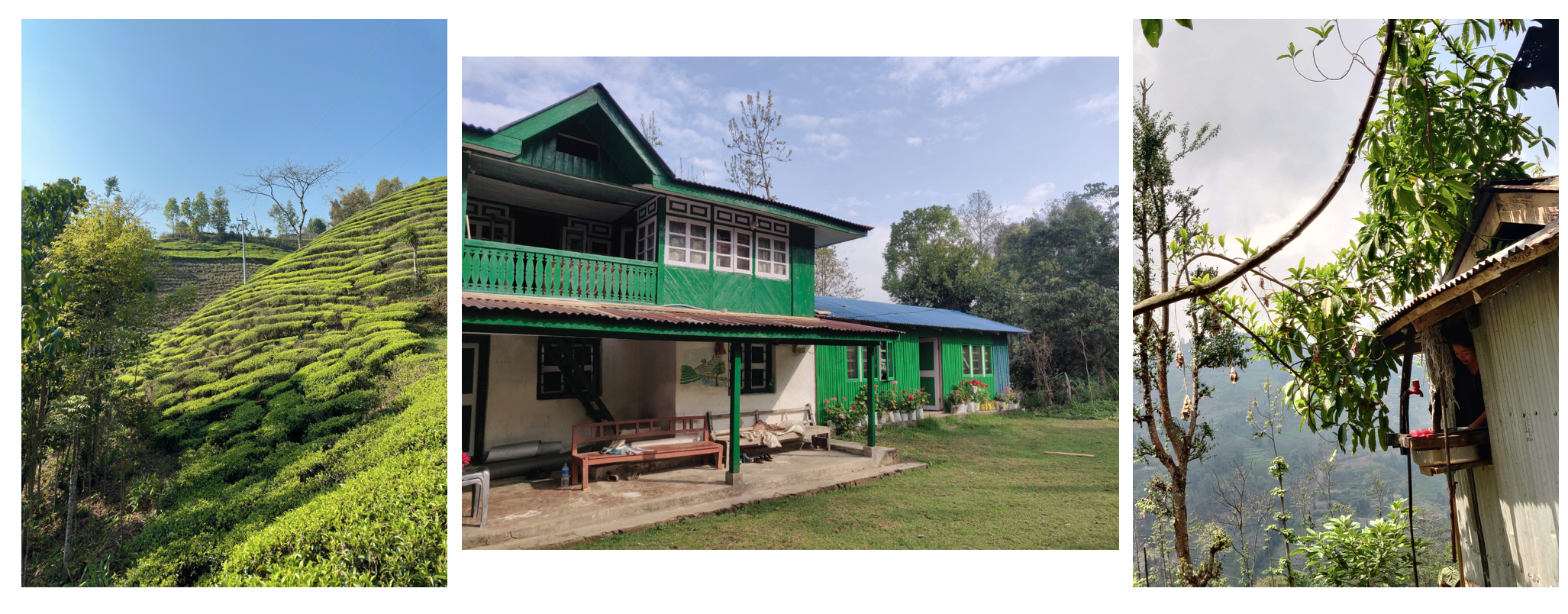
7am - Slowly emerge from our little rooms and fill mugs with freshly brewed, freshly farmed, tea. Sipping on these we would quietly read or write, enjoying the appearance of the sun.
8:30am - Head to the tea terraces just below the house and pick tea.
10am - Meal 1 of the day. Always dal bhat. Always delicious. Always paired with more tea. Followed up with more lying in the sun and reading or writing.
11:30am - Rolling the previously picked tea. Once all the tea was rolled, it was back to the terraces to pick more.
2:30pm - End of work. A snack would be served. Examples are beaten rice with sugar and cinnamon; potato salad; soybean salad with popped rice; roasted chickpeas. The rest of the afternoon was completely our own. I’d do some yoga, sometimes joined by the other volunteers or the two little boys who seemed to always be around. I’d play chess with one of the boys, he was quite a forceful teacher! I’d write and I’d read. We’d chat.
7pm - Meal 2 of the day. Almost always dal bhat. Always different to the earlier dal bhat. Also always delicious. Dinner was usually followed with a game of uno or another card game. More reading or watching some netflix before bed.
It was a very simple life. Usually I’d love the slowness of it all as a break from the usual business of travelling, but after having a similar routine whilst trekking I got a little bored at times!
On Thursdays there was a market in Fikkal, and I visited this with two of the other volunteers to get some supplies. We commented on how we felt like farm girls from history, making the journey to the nearest town on market day. On one day off we travelled to Ilam, the main city in the area. The busy town had beautiful old houses, ancient tea terraces and even a cafe that served proper coffee (you might be able to tell how excited that made me from the photo). I celebrated Easter here, and we did a little Easter egg hunt in the garden, much to the bemusement of the Nepalese family!
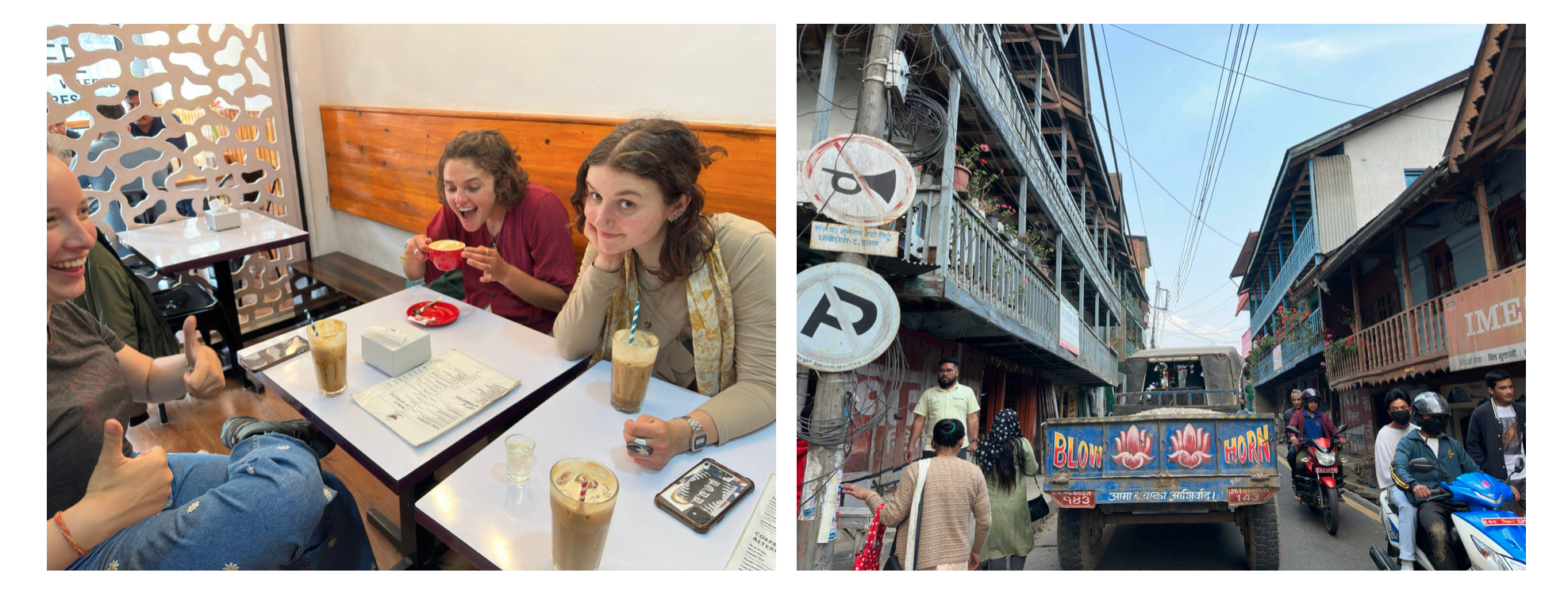
Food
Along with terraces of tea bushes, all sorts of vegetables are grown on the farm and we eat these, substituted with ones bought from the market, at every meal. Kaushila was a marvel in the kitchen, always cooking up delicious meals of dal bhat. In Nepal, it is custom to begin the day with just a cup of tea and have one meal at around 10am, with a second meal at around 7pm. A snack may be eaten in between, but nothing major. It is equally custom that both of these meals are dal bhat, meaning that most Nepalese will eat dal bhat twice a day for most of their lives. Crazy! But it’s not as monotonous as it sounds, dal bhat is very varied. Dal bhat entails a copper plate with high sides filled with piles of rice, dal, vegetables, a potato and vegetable curry, and pickle. Each of these elements will then vary meal to meal; different dal each time, different vegetables prepared in different ways, a different type of curry. So boredom of the meal doesn’t come as quickly as you’d imagine, and I can see how if it was normal for you, you would be perfectly happy eating it twice a day, everyday!

Something that’s surprising, but I did actually already know from a podcast on tea I’d listened to during lockdown, is that all types of tea come from the exact same tea bush. Black tea, green tea and white tea all come from identical leaves, what differs is the later processing. At the Kulang tea farm the tea is organic and hand-picked. The tea bushes were planted 25 years ago and provide leaves for picking each year from April through to November. The bushes are trimmed but that’s it for their upkeep.
The most common stages in tea production


It was really rewarding to learn about the tea process, and I proudly took some of the tea I helped pick, roll and dry away with me!
I enjoyed experiencing real Nepalese life here. Long talks with the family after dinner gave me so many insights into the complicated web of Nepalese culture, where castes and ethnicities and religion crisscross repeatedly. It’s very rich and very alien. Some of it feels very backwards still, for example how women are treated whilst on their periods by some groups, not being permitted to enter the kitchen or prepare food and traditionally being made to sleep with the animals outside. I only spent 10 days at the farm, enough to get a rough feeling for the culture and life but not enough to gain a deep knowledge of it. That rough feeling has left me even more fond of Nepal, with even more of a draw to it. I think it’s safe to say I’ll be visiting again at some point.
Slowing right down at the tea farm, after already having slowed down from the usual pace of travelling whilst hiking, made me realise it wasn’t quite what I was longing for at that time. I was feeling tired and low on energy, but in the way where resting made me feel even more tired. Being active and busy was what I needed to energise myself. With the other volunteers, we spoke about home a lot and what we missed about it. This, unsurprisingly, meant I seriously thought about home for the first time in a while and realised the things I had started to really miss. Especially as I thought about the beginnings of spring and Easter, one of my favourite times of the year. I thought about the BBQs with friends and family I was missing, the delicious food (not just easter eggs, but mostly…), sunny evening swims in the cold sea, home comforts. I wouldn’t say I felt homesick, and I definitely wasn’t ready to go back home, but I missed parts of home relatively badly. I’m glad I felt that way. I’m lucky to have a life back at home that I miss.